Unit 3 Theories, Principals and Models in Education and Training
VerifiedAdded on 2023/06/09
|18
|5801
|440
AI Summary
This report analyses the different theories, principals and models in education and training, including facilitative teaching and learning, behaviourism as a teaching method, and the importance of leadership skills. The report also includes a lesson plan and group discussion activities. The principles of behaviourism are discussed, including classical and operant conditioning, and theories by B.F Skinner, Watson and Ivan Pavlov. The report concludes with a reflection on the effectiveness of using rewards and punishment in leading positive behaviour in the classroom.
Contribute Materials
Your contribution can guide someone’s learning journey. Share your
documents today.
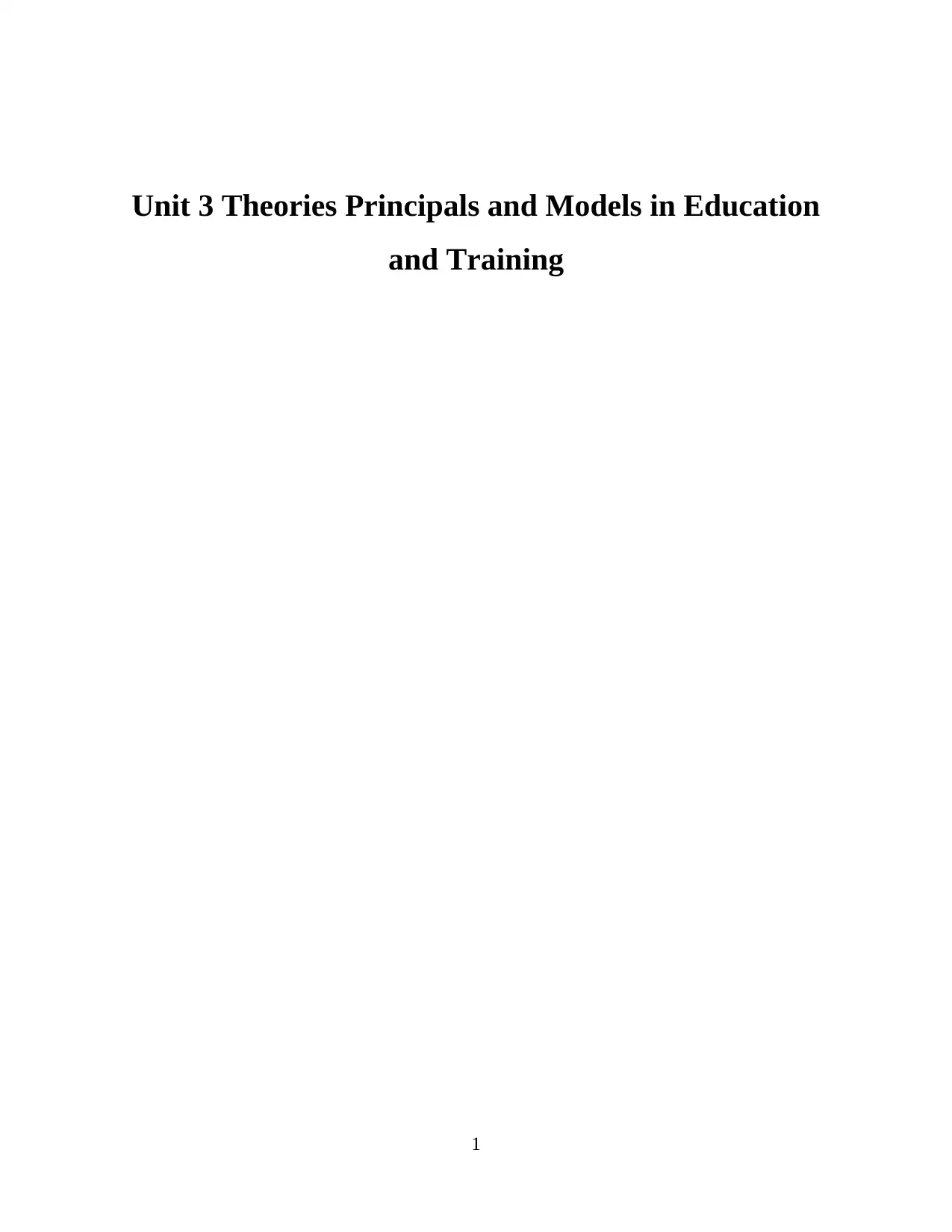
Unit 3 Theories Principals and Models in Education
and Training
1
and Training
1
Secure Best Marks with AI Grader
Need help grading? Try our AI Grader for instant feedback on your assignments.
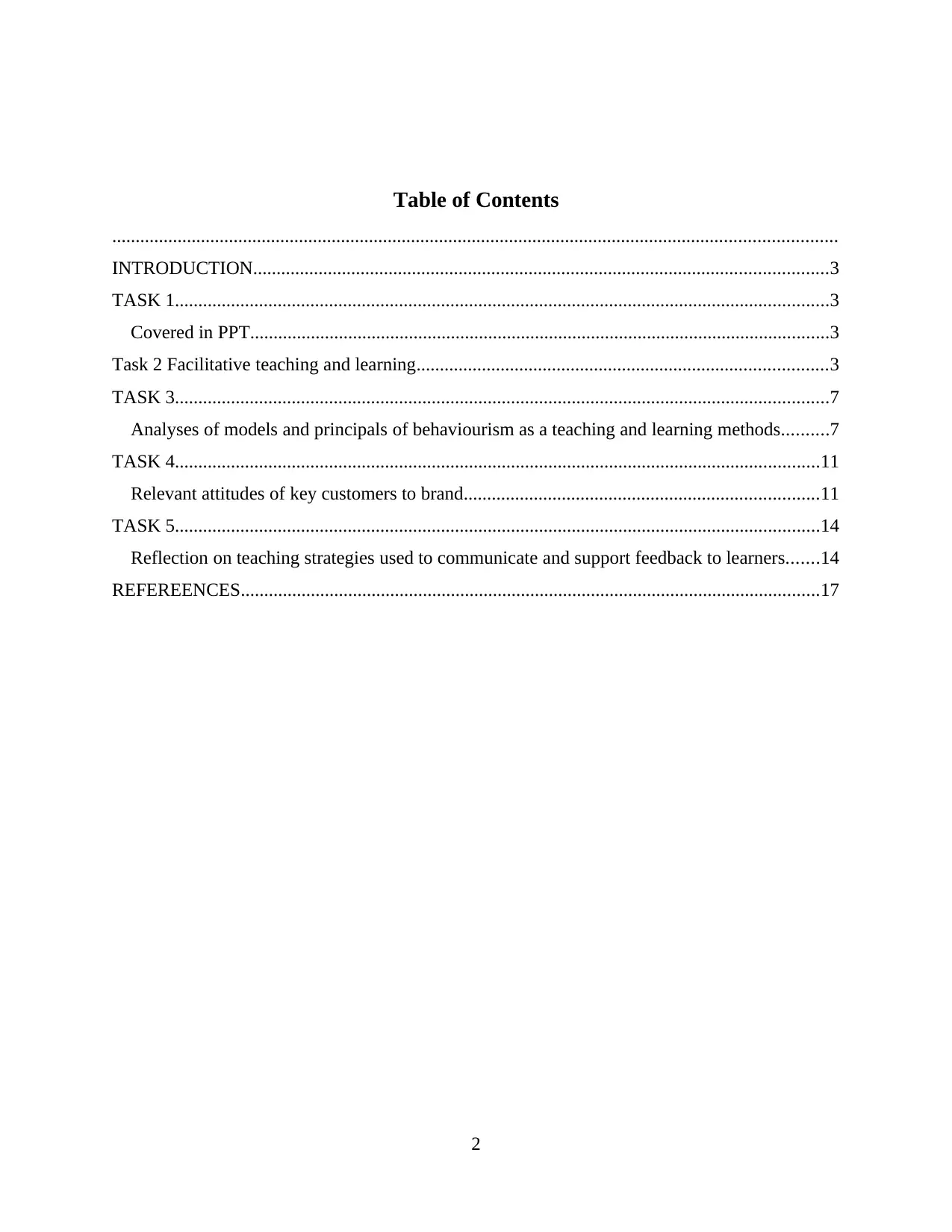
Table of Contents
...........................................................................................................................................................
INTRODUCTION...........................................................................................................................3
TASK 1............................................................................................................................................3
Covered in PPT............................................................................................................................3
Task 2 Facilitative teaching and learning........................................................................................3
TASK 3............................................................................................................................................7
Analyses of models and principals of behaviourism as a teaching and learning methods..........7
TASK 4..........................................................................................................................................11
Relevant attitudes of key customers to brand............................................................................11
TASK 5..........................................................................................................................................14
Reflection on teaching strategies used to communicate and support feedback to learners.......14
REFEREENCES............................................................................................................................17
2
...........................................................................................................................................................
INTRODUCTION...........................................................................................................................3
TASK 1............................................................................................................................................3
Covered in PPT............................................................................................................................3
Task 2 Facilitative teaching and learning........................................................................................3
TASK 3............................................................................................................................................7
Analyses of models and principals of behaviourism as a teaching and learning methods..........7
TASK 4..........................................................................................................................................11
Relevant attitudes of key customers to brand............................................................................11
TASK 5..........................................................................................................................................14
Reflection on teaching strategies used to communicate and support feedback to learners.......14
REFEREENCES............................................................................................................................17
2
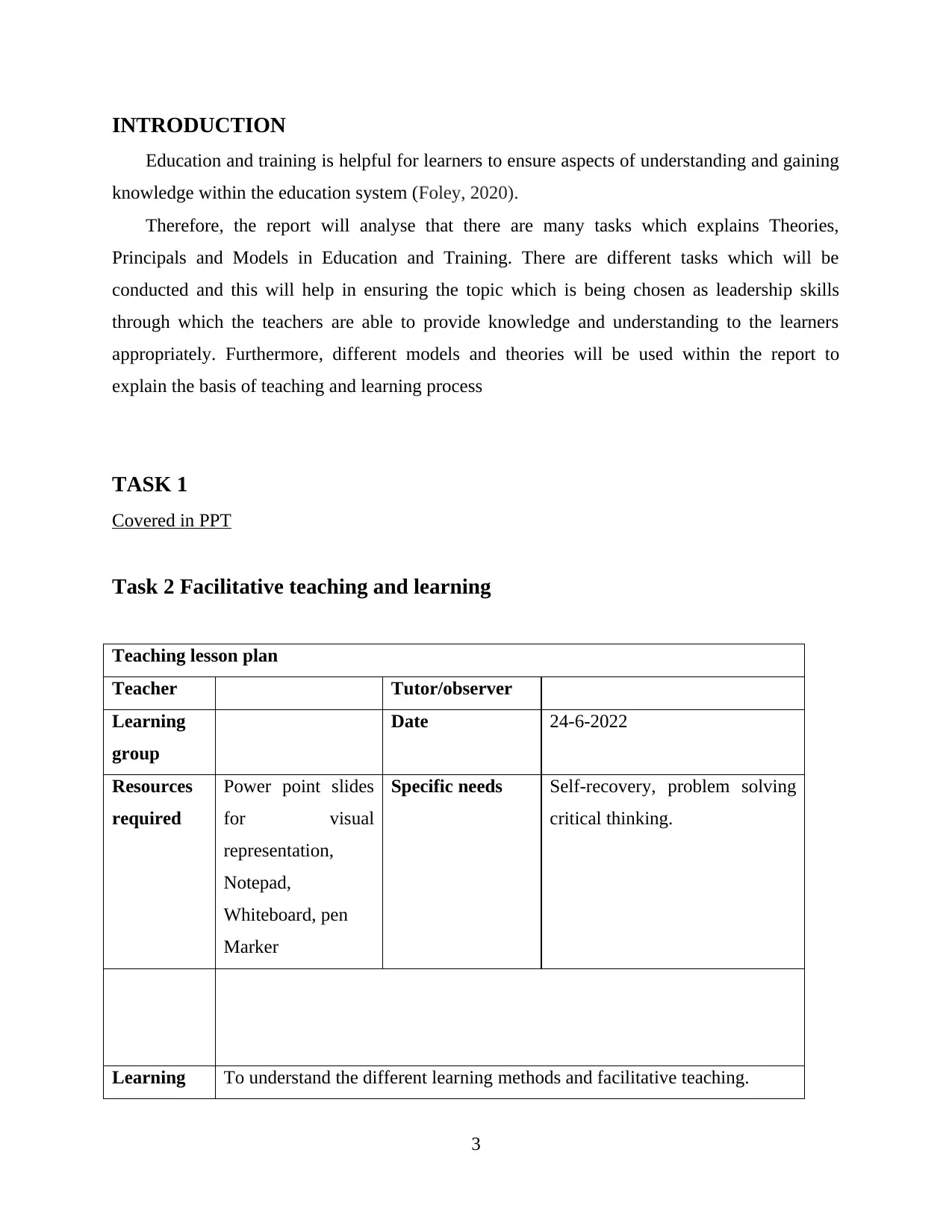
INTRODUCTION
Education and training is helpful for learners to ensure aspects of understanding and gaining
knowledge within the education system (Foley, 2020).
Therefore, the report will analyse that there are many tasks which explains Theories,
Principals and Models in Education and Training. There are different tasks which will be
conducted and this will help in ensuring the topic which is being chosen as leadership skills
through which the teachers are able to provide knowledge and understanding to the learners
appropriately. Furthermore, different models and theories will be used within the report to
explain the basis of teaching and learning process
TASK 1
Covered in PPT
Task 2 Facilitative teaching and learning
Teaching lesson plan
Teacher Tutor/observer
Learning
group
Date 24-6-2022
Resources
required
Power point slides
for visual
representation,
Notepad,
Whiteboard, pen
Marker
Specific needs Self-recovery, problem solving
critical thinking.
Learning To understand the different learning methods and facilitative teaching.
3
Education and training is helpful for learners to ensure aspects of understanding and gaining
knowledge within the education system (Foley, 2020).
Therefore, the report will analyse that there are many tasks which explains Theories,
Principals and Models in Education and Training. There are different tasks which will be
conducted and this will help in ensuring the topic which is being chosen as leadership skills
through which the teachers are able to provide knowledge and understanding to the learners
appropriately. Furthermore, different models and theories will be used within the report to
explain the basis of teaching and learning process
TASK 1
Covered in PPT
Task 2 Facilitative teaching and learning
Teaching lesson plan
Teacher Tutor/observer
Learning
group
Date 24-6-2022
Resources
required
Power point slides
for visual
representation,
Notepad,
Whiteboard, pen
Marker
Specific needs Self-recovery, problem solving
critical thinking.
Learning To understand the different learning methods and facilitative teaching.
3
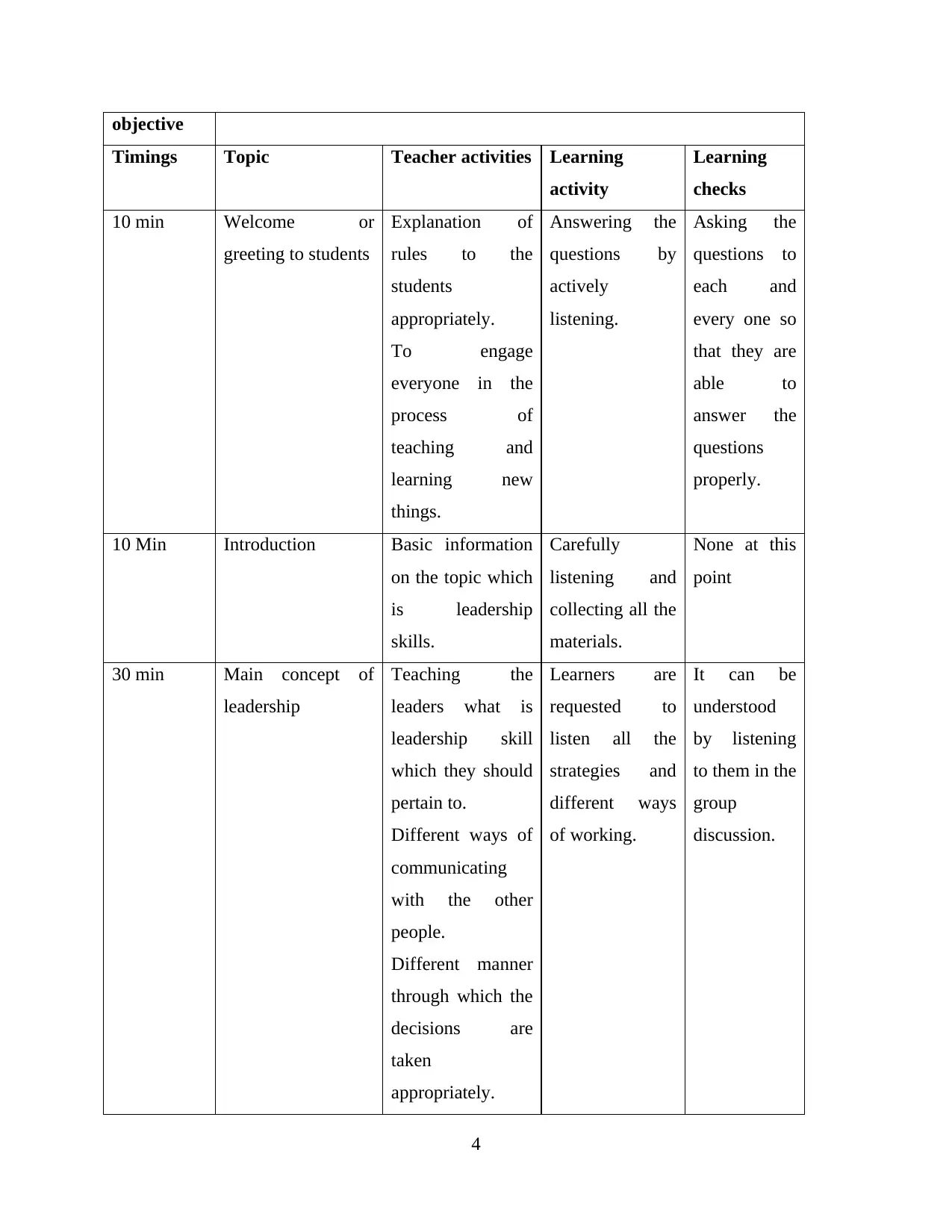
objective
Timings Topic Teacher activities Learning
activity
Learning
checks
10 min Welcome or
greeting to students
Explanation of
rules to the
students
appropriately.
To engage
everyone in the
process of
teaching and
learning new
things.
Answering the
questions by
actively
listening.
Asking the
questions to
each and
every one so
that they are
able to
answer the
questions
properly.
10 Min Introduction Basic information
on the topic which
is leadership
skills.
Carefully
listening and
collecting all the
materials.
None at this
point
30 min Main concept of
leadership
Teaching the
leaders what is
leadership skill
which they should
pertain to.
Different ways of
communicating
with the other
people.
Different manner
through which the
decisions are
taken
appropriately.
Learners are
requested to
listen all the
strategies and
different ways
of working.
It can be
understood
by listening
to them in the
group
discussion.
4
Timings Topic Teacher activities Learning
activity
Learning
checks
10 min Welcome or
greeting to students
Explanation of
rules to the
students
appropriately.
To engage
everyone in the
process of
teaching and
learning new
things.
Answering the
questions by
actively
listening.
Asking the
questions to
each and
every one so
that they are
able to
answer the
questions
properly.
10 Min Introduction Basic information
on the topic which
is leadership
skills.
Carefully
listening and
collecting all the
materials.
None at this
point
30 min Main concept of
leadership
Teaching the
leaders what is
leadership skill
which they should
pertain to.
Different ways of
communicating
with the other
people.
Different manner
through which the
decisions are
taken
appropriately.
Learners are
requested to
listen all the
strategies and
different ways
of working.
It can be
understood
by listening
to them in the
group
discussion.
4
Secure Best Marks with AI Grader
Need help grading? Try our AI Grader for instant feedback on your assignments.
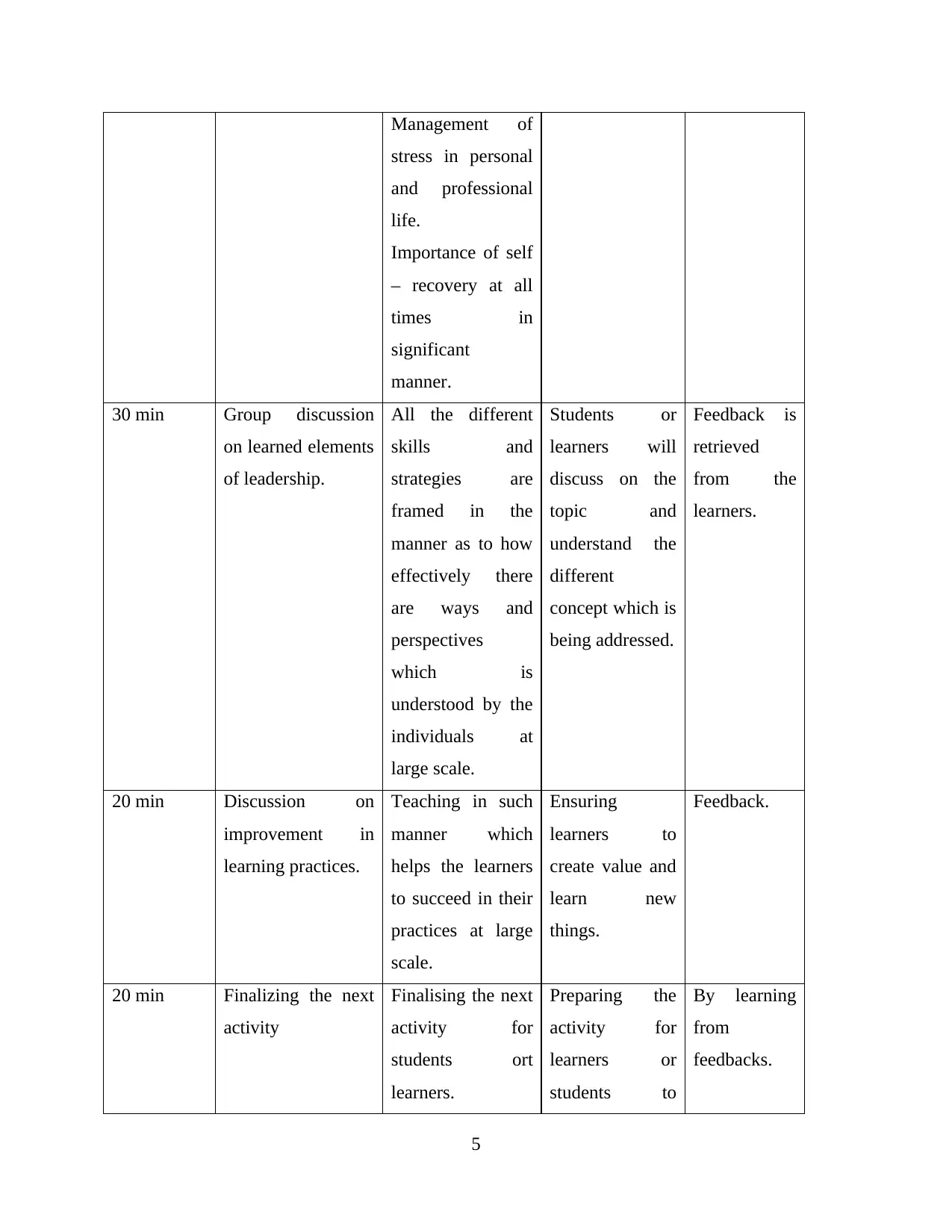
Management of
stress in personal
and professional
life.
Importance of self
– recovery at all
times in
significant
manner.
30 min Group discussion
on learned elements
of leadership.
All the different
skills and
strategies are
framed in the
manner as to how
effectively there
are ways and
perspectives
which is
understood by the
individuals at
large scale.
Students or
learners will
discuss on the
topic and
understand the
different
concept which is
being addressed.
Feedback is
retrieved
from the
learners.
20 min Discussion on
improvement in
learning practices.
Teaching in such
manner which
helps the learners
to succeed in their
practices at large
scale.
Ensuring
learners to
create value and
learn new
things.
Feedback.
20 min Finalizing the next
activity
Finalising the next
activity for
students ort
learners.
Preparing the
activity for
learners or
students to
By learning
from
feedbacks.
5
stress in personal
and professional
life.
Importance of self
– recovery at all
times in
significant
manner.
30 min Group discussion
on learned elements
of leadership.
All the different
skills and
strategies are
framed in the
manner as to how
effectively there
are ways and
perspectives
which is
understood by the
individuals at
large scale.
Students or
learners will
discuss on the
topic and
understand the
different
concept which is
being addressed.
Feedback is
retrieved
from the
learners.
20 min Discussion on
improvement in
learning practices.
Teaching in such
manner which
helps the learners
to succeed in their
practices at large
scale.
Ensuring
learners to
create value and
learn new
things.
Feedback.
20 min Finalizing the next
activity
Finalising the next
activity for
students ort
learners.
Preparing the
activity for
learners or
students to
By learning
from
feedbacks.
5
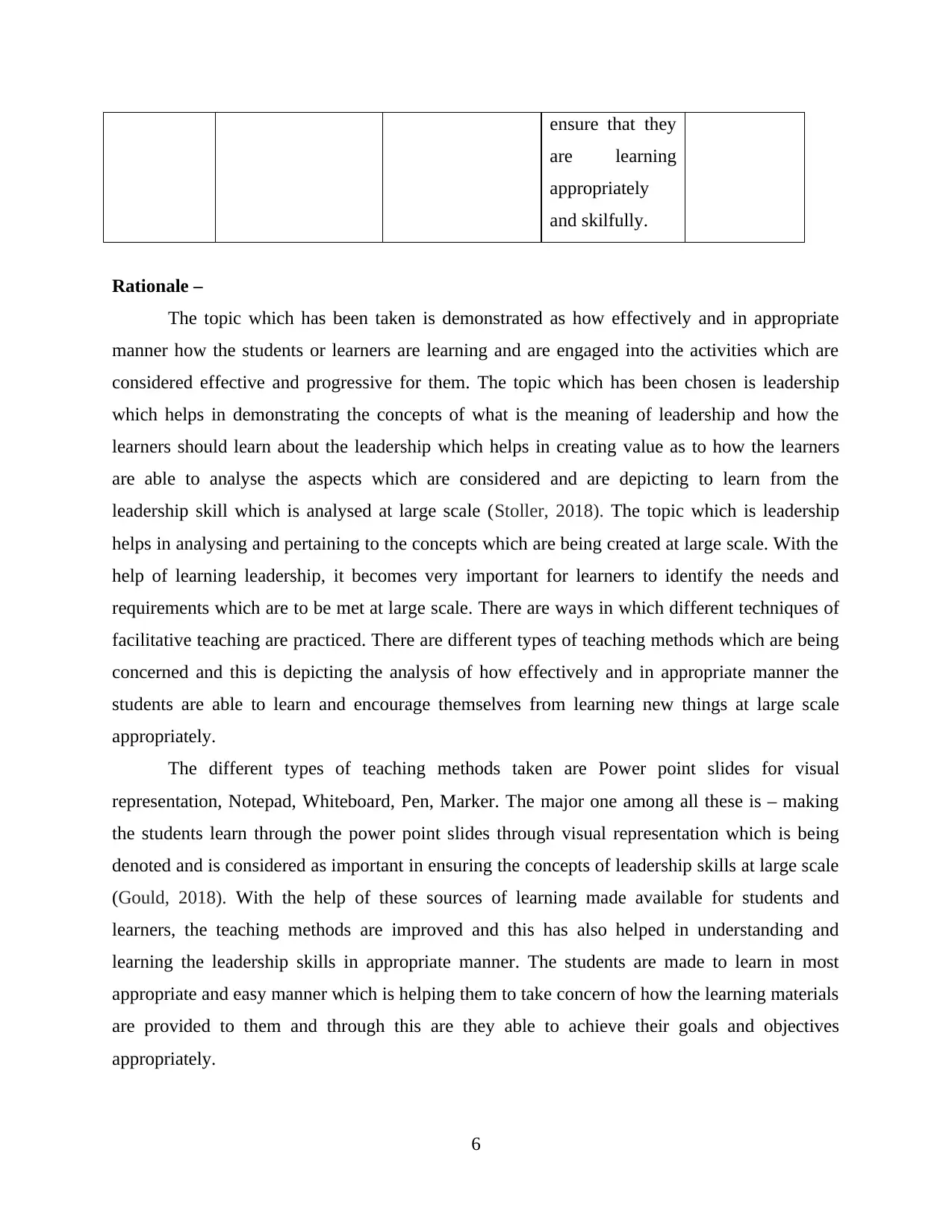
ensure that they
are learning
appropriately
and skilfully.
Rationale –
The topic which has been taken is demonstrated as how effectively and in appropriate
manner how the students or learners are learning and are engaged into the activities which are
considered effective and progressive for them. The topic which has been chosen is leadership
which helps in demonstrating the concepts of what is the meaning of leadership and how the
learners should learn about the leadership which helps in creating value as to how the learners
are able to analyse the aspects which are considered and are depicting to learn from the
leadership skill which is analysed at large scale (Stoller, 2018). The topic which is leadership
helps in analysing and pertaining to the concepts which are being created at large scale. With the
help of learning leadership, it becomes very important for learners to identify the needs and
requirements which are to be met at large scale. There are ways in which different techniques of
facilitative teaching are practiced. There are different types of teaching methods which are being
concerned and this is depicting the analysis of how effectively and in appropriate manner the
students are able to learn and encourage themselves from learning new things at large scale
appropriately.
The different types of teaching methods taken are Power point slides for visual
representation, Notepad, Whiteboard, Pen, Marker. The major one among all these is – making
the students learn through the power point slides through visual representation which is being
denoted and is considered as important in ensuring the concepts of leadership skills at large scale
(Gould, 2018). With the help of these sources of learning made available for students and
learners, the teaching methods are improved and this has also helped in understanding and
learning the leadership skills in appropriate manner. The students are made to learn in most
appropriate and easy manner which is helping them to take concern of how the learning materials
are provided to them and through this are they able to achieve their goals and objectives
appropriately.
6
are learning
appropriately
and skilfully.
Rationale –
The topic which has been taken is demonstrated as how effectively and in appropriate
manner how the students or learners are learning and are engaged into the activities which are
considered effective and progressive for them. The topic which has been chosen is leadership
which helps in demonstrating the concepts of what is the meaning of leadership and how the
learners should learn about the leadership which helps in creating value as to how the learners
are able to analyse the aspects which are considered and are depicting to learn from the
leadership skill which is analysed at large scale (Stoller, 2018). The topic which is leadership
helps in analysing and pertaining to the concepts which are being created at large scale. With the
help of learning leadership, it becomes very important for learners to identify the needs and
requirements which are to be met at large scale. There are ways in which different techniques of
facilitative teaching are practiced. There are different types of teaching methods which are being
concerned and this is depicting the analysis of how effectively and in appropriate manner the
students are able to learn and encourage themselves from learning new things at large scale
appropriately.
The different types of teaching methods taken are Power point slides for visual
representation, Notepad, Whiteboard, Pen, Marker. The major one among all these is – making
the students learn through the power point slides through visual representation which is being
denoted and is considered as important in ensuring the concepts of leadership skills at large scale
(Gould, 2018). With the help of these sources of learning made available for students and
learners, the teaching methods are improved and this has also helped in understanding and
learning the leadership skills in appropriate manner. The students are made to learn in most
appropriate and easy manner which is helping them to take concern of how the learning materials
are provided to them and through this are they able to achieve their goals and objectives
appropriately.
6
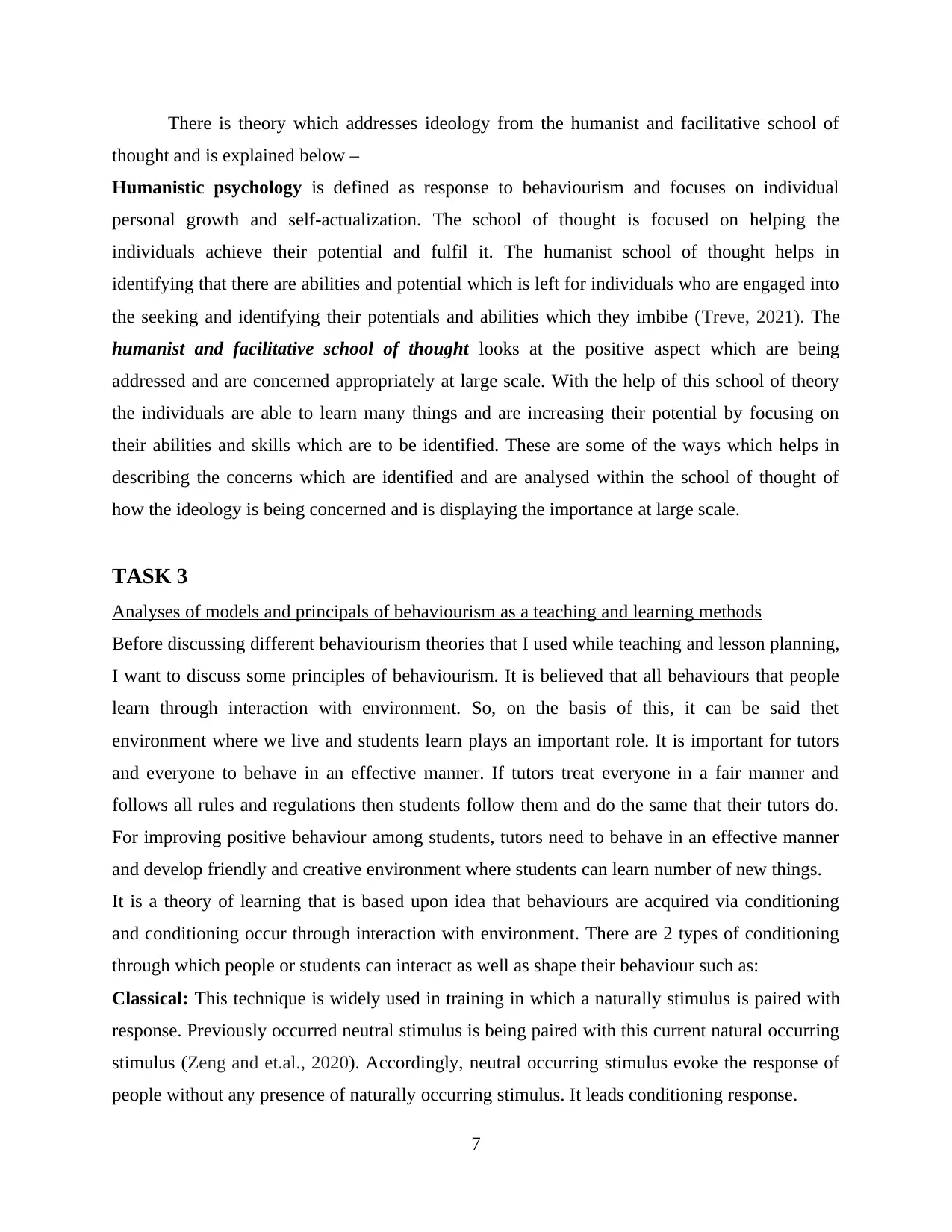
There is theory which addresses ideology from the humanist and facilitative school of
thought and is explained below –
Humanistic psychology is defined as response to behaviourism and focuses on individual
personal growth and self-actualization. The school of thought is focused on helping the
individuals achieve their potential and fulfil it. The humanist school of thought helps in
identifying that there are abilities and potential which is left for individuals who are engaged into
the seeking and identifying their potentials and abilities which they imbibe (Treve, 2021). The
humanist and facilitative school of thought looks at the positive aspect which are being
addressed and are concerned appropriately at large scale. With the help of this school of theory
the individuals are able to learn many things and are increasing their potential by focusing on
their abilities and skills which are to be identified. These are some of the ways which helps in
describing the concerns which are identified and are analysed within the school of thought of
how the ideology is being concerned and is displaying the importance at large scale.
TASK 3
Analyses of models and principals of behaviourism as a teaching and learning methods
Before discussing different behaviourism theories that I used while teaching and lesson planning,
I want to discuss some principles of behaviourism. It is believed that all behaviours that people
learn through interaction with environment. So, on the basis of this, it can be said thet
environment where we live and students learn plays an important role. It is important for tutors
and everyone to behave in an effective manner. If tutors treat everyone in a fair manner and
follows all rules and regulations then students follow them and do the same that their tutors do.
For improving positive behaviour among students, tutors need to behave in an effective manner
and develop friendly and creative environment where students can learn number of new things.
It is a theory of learning that is based upon idea that behaviours are acquired via conditioning
and conditioning occur through interaction with environment. There are 2 types of conditioning
through which people or students can interact as well as shape their behaviour such as:
Classical: This technique is widely used in training in which a naturally stimulus is paired with
response. Previously occurred neutral stimulus is being paired with this current natural occurring
stimulus (Zeng and et.al., 2020). Accordingly, neutral occurring stimulus evoke the response of
people without any presence of naturally occurring stimulus. It leads conditioning response.
7
thought and is explained below –
Humanistic psychology is defined as response to behaviourism and focuses on individual
personal growth and self-actualization. The school of thought is focused on helping the
individuals achieve their potential and fulfil it. The humanist school of thought helps in
identifying that there are abilities and potential which is left for individuals who are engaged into
the seeking and identifying their potentials and abilities which they imbibe (Treve, 2021). The
humanist and facilitative school of thought looks at the positive aspect which are being
addressed and are concerned appropriately at large scale. With the help of this school of theory
the individuals are able to learn many things and are increasing their potential by focusing on
their abilities and skills which are to be identified. These are some of the ways which helps in
describing the concerns which are identified and are analysed within the school of thought of
how the ideology is being concerned and is displaying the importance at large scale.
TASK 3
Analyses of models and principals of behaviourism as a teaching and learning methods
Before discussing different behaviourism theories that I used while teaching and lesson planning,
I want to discuss some principles of behaviourism. It is believed that all behaviours that people
learn through interaction with environment. So, on the basis of this, it can be said thet
environment where we live and students learn plays an important role. It is important for tutors
and everyone to behave in an effective manner. If tutors treat everyone in a fair manner and
follows all rules and regulations then students follow them and do the same that their tutors do.
For improving positive behaviour among students, tutors need to behave in an effective manner
and develop friendly and creative environment where students can learn number of new things.
It is a theory of learning that is based upon idea that behaviours are acquired via conditioning
and conditioning occur through interaction with environment. There are 2 types of conditioning
through which people or students can interact as well as shape their behaviour such as:
Classical: This technique is widely used in training in which a naturally stimulus is paired with
response. Previously occurred neutral stimulus is being paired with this current natural occurring
stimulus (Zeng and et.al., 2020). Accordingly, neutral occurring stimulus evoke the response of
people without any presence of naturally occurring stimulus. It leads conditioning response.
7
Paraphrase This Document
Need a fresh take? Get an instant paraphrase of this document with our AI Paraphraser
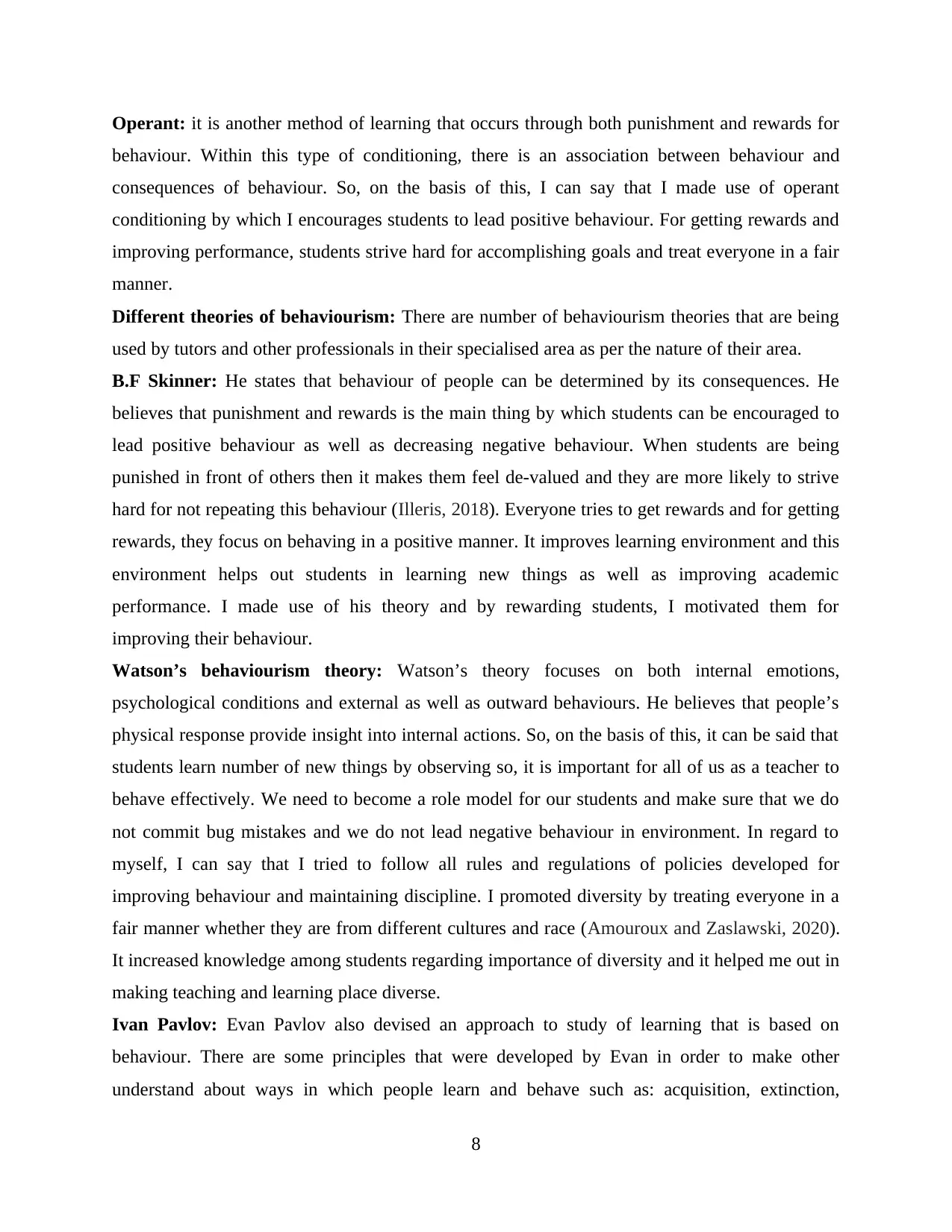
Operant: it is another method of learning that occurs through both punishment and rewards for
behaviour. Within this type of conditioning, there is an association between behaviour and
consequences of behaviour. So, on the basis of this, I can say that I made use of operant
conditioning by which I encourages students to lead positive behaviour. For getting rewards and
improving performance, students strive hard for accomplishing goals and treat everyone in a fair
manner.
Different theories of behaviourism: There are number of behaviourism theories that are being
used by tutors and other professionals in their specialised area as per the nature of their area.
B.F Skinner: He states that behaviour of people can be determined by its consequences. He
believes that punishment and rewards is the main thing by which students can be encouraged to
lead positive behaviour as well as decreasing negative behaviour. When students are being
punished in front of others then it makes them feel de-valued and they are more likely to strive
hard for not repeating this behaviour (Illeris, 2018). Everyone tries to get rewards and for getting
rewards, they focus on behaving in a positive manner. It improves learning environment and this
environment helps out students in learning new things as well as improving academic
performance. I made use of his theory and by rewarding students, I motivated them for
improving their behaviour.
Watson’s behaviourism theory: Watson’s theory focuses on both internal emotions,
psychological conditions and external as well as outward behaviours. He believes that people’s
physical response provide insight into internal actions. So, on the basis of this, it can be said that
students learn number of new things by observing so, it is important for all of us as a teacher to
behave effectively. We need to become a role model for our students and make sure that we do
not commit bug mistakes and we do not lead negative behaviour in environment. In regard to
myself, I can say that I tried to follow all rules and regulations of policies developed for
improving behaviour and maintaining discipline. I promoted diversity by treating everyone in a
fair manner whether they are from different cultures and race (Amouroux and Zaslawski, 2020).
It increased knowledge among students regarding importance of diversity and it helped me out in
making teaching and learning place diverse.
Ivan Pavlov: Evan Pavlov also devised an approach to study of learning that is based on
behaviour. There are some principles that were developed by Evan in order to make other
understand about ways in which people learn and behave such as: acquisition, extinction,
8
behaviour. Within this type of conditioning, there is an association between behaviour and
consequences of behaviour. So, on the basis of this, I can say that I made use of operant
conditioning by which I encourages students to lead positive behaviour. For getting rewards and
improving performance, students strive hard for accomplishing goals and treat everyone in a fair
manner.
Different theories of behaviourism: There are number of behaviourism theories that are being
used by tutors and other professionals in their specialised area as per the nature of their area.
B.F Skinner: He states that behaviour of people can be determined by its consequences. He
believes that punishment and rewards is the main thing by which students can be encouraged to
lead positive behaviour as well as decreasing negative behaviour. When students are being
punished in front of others then it makes them feel de-valued and they are more likely to strive
hard for not repeating this behaviour (Illeris, 2018). Everyone tries to get rewards and for getting
rewards, they focus on behaving in a positive manner. It improves learning environment and this
environment helps out students in learning new things as well as improving academic
performance. I made use of his theory and by rewarding students, I motivated them for
improving their behaviour.
Watson’s behaviourism theory: Watson’s theory focuses on both internal emotions,
psychological conditions and external as well as outward behaviours. He believes that people’s
physical response provide insight into internal actions. So, on the basis of this, it can be said that
students learn number of new things by observing so, it is important for all of us as a teacher to
behave effectively. We need to become a role model for our students and make sure that we do
not commit bug mistakes and we do not lead negative behaviour in environment. In regard to
myself, I can say that I tried to follow all rules and regulations of policies developed for
improving behaviour and maintaining discipline. I promoted diversity by treating everyone in a
fair manner whether they are from different cultures and race (Amouroux and Zaslawski, 2020).
It increased knowledge among students regarding importance of diversity and it helped me out in
making teaching and learning place diverse.
Ivan Pavlov: Evan Pavlov also devised an approach to study of learning that is based on
behaviour. There are some principles that were developed by Evan in order to make other
understand about ways in which people learn and behave such as: acquisition, extinction,
8
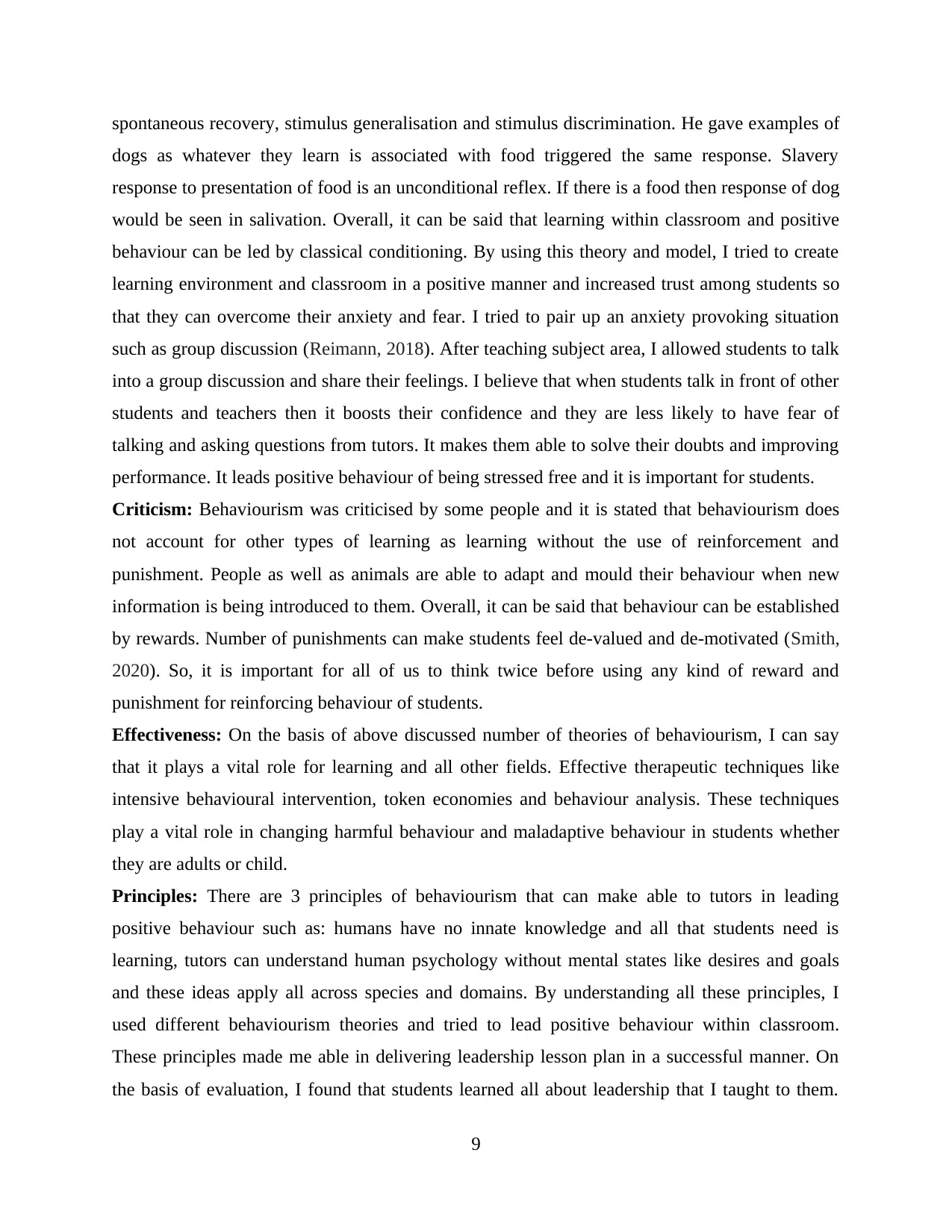
spontaneous recovery, stimulus generalisation and stimulus discrimination. He gave examples of
dogs as whatever they learn is associated with food triggered the same response. Slavery
response to presentation of food is an unconditional reflex. If there is a food then response of dog
would be seen in salivation. Overall, it can be said that learning within classroom and positive
behaviour can be led by classical conditioning. By using this theory and model, I tried to create
learning environment and classroom in a positive manner and increased trust among students so
that they can overcome their anxiety and fear. I tried to pair up an anxiety provoking situation
such as group discussion (Reimann, 2018). After teaching subject area, I allowed students to talk
into a group discussion and share their feelings. I believe that when students talk in front of other
students and teachers then it boosts their confidence and they are less likely to have fear of
talking and asking questions from tutors. It makes them able to solve their doubts and improving
performance. It leads positive behaviour of being stressed free and it is important for students.
Criticism: Behaviourism was criticised by some people and it is stated that behaviourism does
not account for other types of learning as learning without the use of reinforcement and
punishment. People as well as animals are able to adapt and mould their behaviour when new
information is being introduced to them. Overall, it can be said that behaviour can be established
by rewards. Number of punishments can make students feel de-valued and de-motivated (Smith,
2020). So, it is important for all of us to think twice before using any kind of reward and
punishment for reinforcing behaviour of students.
Effectiveness: On the basis of above discussed number of theories of behaviourism, I can say
that it plays a vital role for learning and all other fields. Effective therapeutic techniques like
intensive behavioural intervention, token economies and behaviour analysis. These techniques
play a vital role in changing harmful behaviour and maladaptive behaviour in students whether
they are adults or child.
Principles: There are 3 principles of behaviourism that can make able to tutors in leading
positive behaviour such as: humans have no innate knowledge and all that students need is
learning, tutors can understand human psychology without mental states like desires and goals
and these ideas apply all across species and domains. By understanding all these principles, I
used different behaviourism theories and tried to lead positive behaviour within classroom.
These principles made me able in delivering leadership lesson plan in a successful manner. On
the basis of evaluation, I found that students learned all about leadership that I taught to them.
9
dogs as whatever they learn is associated with food triggered the same response. Slavery
response to presentation of food is an unconditional reflex. If there is a food then response of dog
would be seen in salivation. Overall, it can be said that learning within classroom and positive
behaviour can be led by classical conditioning. By using this theory and model, I tried to create
learning environment and classroom in a positive manner and increased trust among students so
that they can overcome their anxiety and fear. I tried to pair up an anxiety provoking situation
such as group discussion (Reimann, 2018). After teaching subject area, I allowed students to talk
into a group discussion and share their feelings. I believe that when students talk in front of other
students and teachers then it boosts their confidence and they are less likely to have fear of
talking and asking questions from tutors. It makes them able to solve their doubts and improving
performance. It leads positive behaviour of being stressed free and it is important for students.
Criticism: Behaviourism was criticised by some people and it is stated that behaviourism does
not account for other types of learning as learning without the use of reinforcement and
punishment. People as well as animals are able to adapt and mould their behaviour when new
information is being introduced to them. Overall, it can be said that behaviour can be established
by rewards. Number of punishments can make students feel de-valued and de-motivated (Smith,
2020). So, it is important for all of us to think twice before using any kind of reward and
punishment for reinforcing behaviour of students.
Effectiveness: On the basis of above discussed number of theories of behaviourism, I can say
that it plays a vital role for learning and all other fields. Effective therapeutic techniques like
intensive behavioural intervention, token economies and behaviour analysis. These techniques
play a vital role in changing harmful behaviour and maladaptive behaviour in students whether
they are adults or child.
Principles: There are 3 principles of behaviourism that can make able to tutors in leading
positive behaviour such as: humans have no innate knowledge and all that students need is
learning, tutors can understand human psychology without mental states like desires and goals
and these ideas apply all across species and domains. By understanding all these principles, I
used different behaviourism theories and tried to lead positive behaviour within classroom.
These principles made me able in delivering leadership lesson plan in a successful manner. On
the basis of evaluation, I found that students learned all about leadership that I taught to them.
9
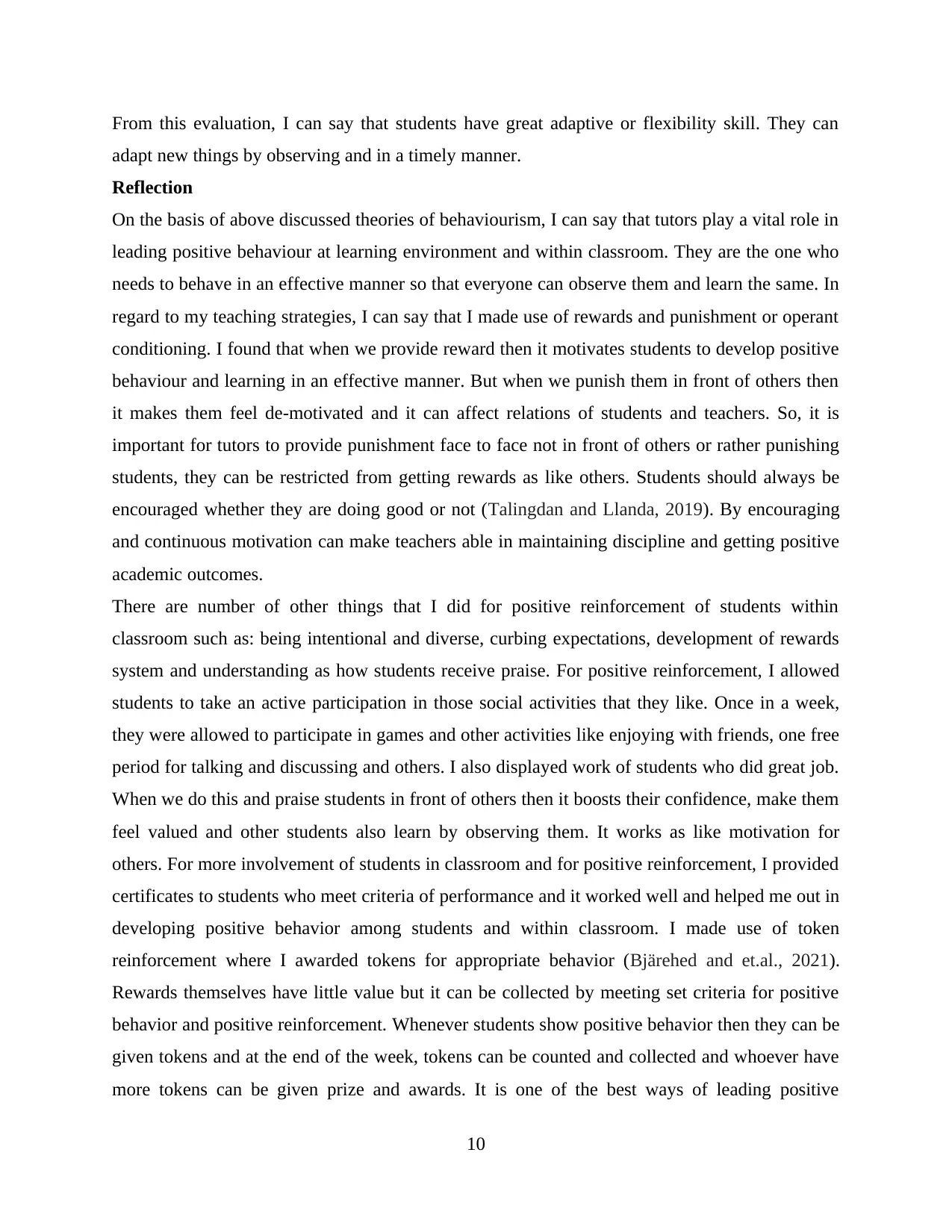
From this evaluation, I can say that students have great adaptive or flexibility skill. They can
adapt new things by observing and in a timely manner.
Reflection
On the basis of above discussed theories of behaviourism, I can say that tutors play a vital role in
leading positive behaviour at learning environment and within classroom. They are the one who
needs to behave in an effective manner so that everyone can observe them and learn the same. In
regard to my teaching strategies, I can say that I made use of rewards and punishment or operant
conditioning. I found that when we provide reward then it motivates students to develop positive
behaviour and learning in an effective manner. But when we punish them in front of others then
it makes them feel de-motivated and it can affect relations of students and teachers. So, it is
important for tutors to provide punishment face to face not in front of others or rather punishing
students, they can be restricted from getting rewards as like others. Students should always be
encouraged whether they are doing good or not (Talingdan and Llanda, 2019). By encouraging
and continuous motivation can make teachers able in maintaining discipline and getting positive
academic outcomes.
There are number of other things that I did for positive reinforcement of students within
classroom such as: being intentional and diverse, curbing expectations, development of rewards
system and understanding as how students receive praise. For positive reinforcement, I allowed
students to take an active participation in those social activities that they like. Once in a week,
they were allowed to participate in games and other activities like enjoying with friends, one free
period for talking and discussing and others. I also displayed work of students who did great job.
When we do this and praise students in front of others then it boosts their confidence, make them
feel valued and other students also learn by observing them. It works as like motivation for
others. For more involvement of students in classroom and for positive reinforcement, I provided
certificates to students who meet criteria of performance and it worked well and helped me out in
developing positive behavior among students and within classroom. I made use of token
reinforcement where I awarded tokens for appropriate behavior (Bjärehed and et.al., 2021).
Rewards themselves have little value but it can be collected by meeting set criteria for positive
behavior and positive reinforcement. Whenever students show positive behavior then they can be
given tokens and at the end of the week, tokens can be counted and collected and whoever have
more tokens can be given prize and awards. It is one of the best ways of leading positive
10
adapt new things by observing and in a timely manner.
Reflection
On the basis of above discussed theories of behaviourism, I can say that tutors play a vital role in
leading positive behaviour at learning environment and within classroom. They are the one who
needs to behave in an effective manner so that everyone can observe them and learn the same. In
regard to my teaching strategies, I can say that I made use of rewards and punishment or operant
conditioning. I found that when we provide reward then it motivates students to develop positive
behaviour and learning in an effective manner. But when we punish them in front of others then
it makes them feel de-motivated and it can affect relations of students and teachers. So, it is
important for tutors to provide punishment face to face not in front of others or rather punishing
students, they can be restricted from getting rewards as like others. Students should always be
encouraged whether they are doing good or not (Talingdan and Llanda, 2019). By encouraging
and continuous motivation can make teachers able in maintaining discipline and getting positive
academic outcomes.
There are number of other things that I did for positive reinforcement of students within
classroom such as: being intentional and diverse, curbing expectations, development of rewards
system and understanding as how students receive praise. For positive reinforcement, I allowed
students to take an active participation in those social activities that they like. Once in a week,
they were allowed to participate in games and other activities like enjoying with friends, one free
period for talking and discussing and others. I also displayed work of students who did great job.
When we do this and praise students in front of others then it boosts their confidence, make them
feel valued and other students also learn by observing them. It works as like motivation for
others. For more involvement of students in classroom and for positive reinforcement, I provided
certificates to students who meet criteria of performance and it worked well and helped me out in
developing positive behavior among students and within classroom. I made use of token
reinforcement where I awarded tokens for appropriate behavior (Bjärehed and et.al., 2021).
Rewards themselves have little value but it can be collected by meeting set criteria for positive
behavior and positive reinforcement. Whenever students show positive behavior then they can be
given tokens and at the end of the week, tokens can be counted and collected and whoever have
more tokens can be given prize and awards. It is one of the best ways of leading positive
10
Secure Best Marks with AI Grader
Need help grading? Try our AI Grader for instant feedback on your assignments.
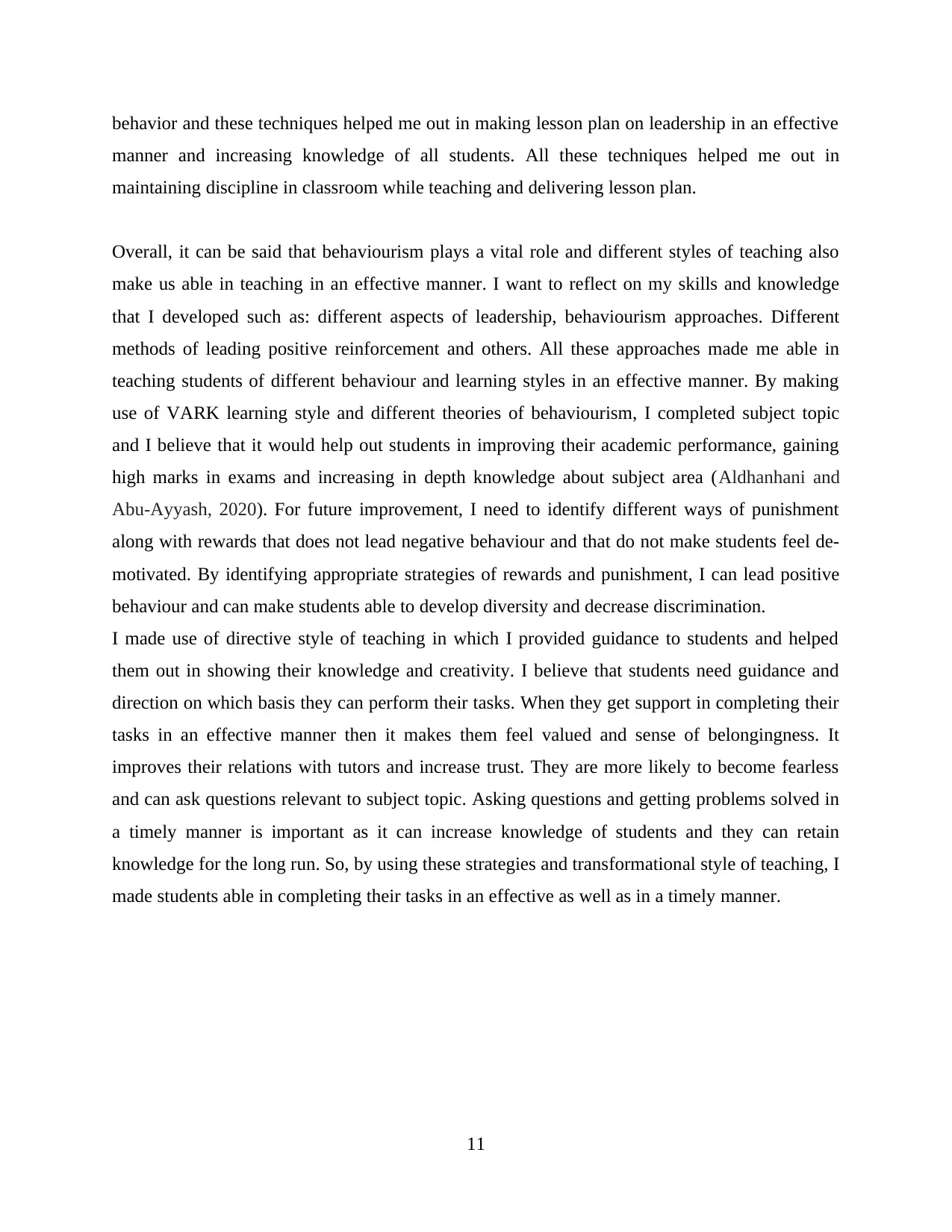
behavior and these techniques helped me out in making lesson plan on leadership in an effective
manner and increasing knowledge of all students. All these techniques helped me out in
maintaining discipline in classroom while teaching and delivering lesson plan.
Overall, it can be said that behaviourism plays a vital role and different styles of teaching also
make us able in teaching in an effective manner. I want to reflect on my skills and knowledge
that I developed such as: different aspects of leadership, behaviourism approaches. Different
methods of leading positive reinforcement and others. All these approaches made me able in
teaching students of different behaviour and learning styles in an effective manner. By making
use of VARK learning style and different theories of behaviourism, I completed subject topic
and I believe that it would help out students in improving their academic performance, gaining
high marks in exams and increasing in depth knowledge about subject area (Aldhanhani and
Abu-Ayyash, 2020). For future improvement, I need to identify different ways of punishment
along with rewards that does not lead negative behaviour and that do not make students feel de-
motivated. By identifying appropriate strategies of rewards and punishment, I can lead positive
behaviour and can make students able to develop diversity and decrease discrimination.
I made use of directive style of teaching in which I provided guidance to students and helped
them out in showing their knowledge and creativity. I believe that students need guidance and
direction on which basis they can perform their tasks. When they get support in completing their
tasks in an effective manner then it makes them feel valued and sense of belongingness. It
improves their relations with tutors and increase trust. They are more likely to become fearless
and can ask questions relevant to subject topic. Asking questions and getting problems solved in
a timely manner is important as it can increase knowledge of students and they can retain
knowledge for the long run. So, by using these strategies and transformational style of teaching, I
made students able in completing their tasks in an effective as well as in a timely manner.
11
manner and increasing knowledge of all students. All these techniques helped me out in
maintaining discipline in classroom while teaching and delivering lesson plan.
Overall, it can be said that behaviourism plays a vital role and different styles of teaching also
make us able in teaching in an effective manner. I want to reflect on my skills and knowledge
that I developed such as: different aspects of leadership, behaviourism approaches. Different
methods of leading positive reinforcement and others. All these approaches made me able in
teaching students of different behaviour and learning styles in an effective manner. By making
use of VARK learning style and different theories of behaviourism, I completed subject topic
and I believe that it would help out students in improving their academic performance, gaining
high marks in exams and increasing in depth knowledge about subject area (Aldhanhani and
Abu-Ayyash, 2020). For future improvement, I need to identify different ways of punishment
along with rewards that does not lead negative behaviour and that do not make students feel de-
motivated. By identifying appropriate strategies of rewards and punishment, I can lead positive
behaviour and can make students able to develop diversity and decrease discrimination.
I made use of directive style of teaching in which I provided guidance to students and helped
them out in showing their knowledge and creativity. I believe that students need guidance and
direction on which basis they can perform their tasks. When they get support in completing their
tasks in an effective manner then it makes them feel valued and sense of belongingness. It
improves their relations with tutors and increase trust. They are more likely to become fearless
and can ask questions relevant to subject topic. Asking questions and getting problems solved in
a timely manner is important as it can increase knowledge of students and they can retain
knowledge for the long run. So, by using these strategies and transformational style of teaching, I
made students able in completing their tasks in an effective as well as in a timely manner.
11
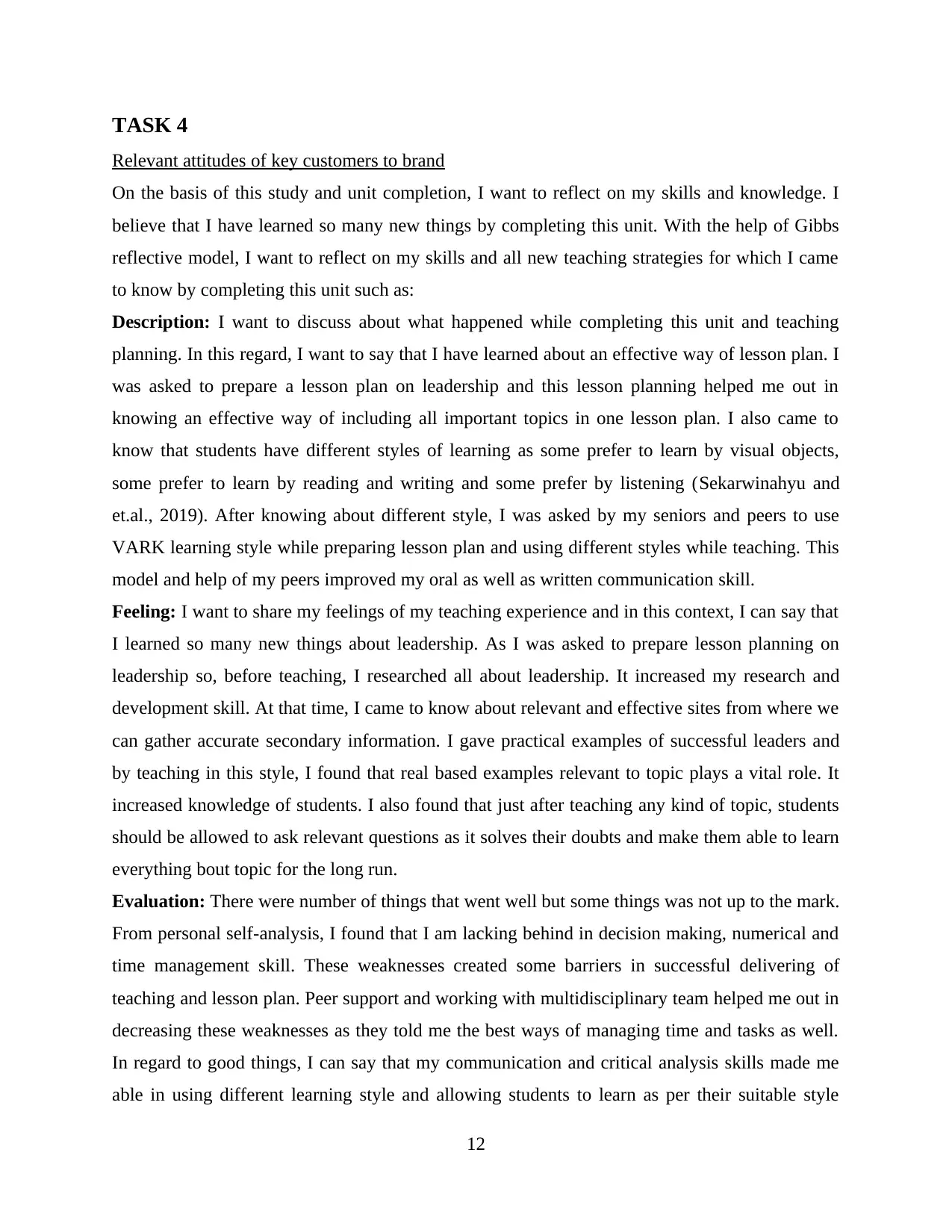
TASK 4
Relevant attitudes of key customers to brand
On the basis of this study and unit completion, I want to reflect on my skills and knowledge. I
believe that I have learned so many new things by completing this unit. With the help of Gibbs
reflective model, I want to reflect on my skills and all new teaching strategies for which I came
to know by completing this unit such as:
Description: I want to discuss about what happened while completing this unit and teaching
planning. In this regard, I want to say that I have learned about an effective way of lesson plan. I
was asked to prepare a lesson plan on leadership and this lesson planning helped me out in
knowing an effective way of including all important topics in one lesson plan. I also came to
know that students have different styles of learning as some prefer to learn by visual objects,
some prefer to learn by reading and writing and some prefer by listening (Sekarwinahyu and
et.al., 2019). After knowing about different style, I was asked by my seniors and peers to use
VARK learning style while preparing lesson plan and using different styles while teaching. This
model and help of my peers improved my oral as well as written communication skill.
Feeling: I want to share my feelings of my teaching experience and in this context, I can say that
I learned so many new things about leadership. As I was asked to prepare lesson planning on
leadership so, before teaching, I researched all about leadership. It increased my research and
development skill. At that time, I came to know about relevant and effective sites from where we
can gather accurate secondary information. I gave practical examples of successful leaders and
by teaching in this style, I found that real based examples relevant to topic plays a vital role. It
increased knowledge of students. I also found that just after teaching any kind of topic, students
should be allowed to ask relevant questions as it solves their doubts and make them able to learn
everything bout topic for the long run.
Evaluation: There were number of things that went well but some things was not up to the mark.
From personal self-analysis, I found that I am lacking behind in decision making, numerical and
time management skill. These weaknesses created some barriers in successful delivering of
teaching and lesson plan. Peer support and working with multidisciplinary team helped me out in
decreasing these weaknesses as they told me the best ways of managing time and tasks as well.
In regard to good things, I can say that my communication and critical analysis skills made me
able in using different learning style and allowing students to learn as per their suitable style
12
Relevant attitudes of key customers to brand
On the basis of this study and unit completion, I want to reflect on my skills and knowledge. I
believe that I have learned so many new things by completing this unit. With the help of Gibbs
reflective model, I want to reflect on my skills and all new teaching strategies for which I came
to know by completing this unit such as:
Description: I want to discuss about what happened while completing this unit and teaching
planning. In this regard, I want to say that I have learned about an effective way of lesson plan. I
was asked to prepare a lesson plan on leadership and this lesson planning helped me out in
knowing an effective way of including all important topics in one lesson plan. I also came to
know that students have different styles of learning as some prefer to learn by visual objects,
some prefer to learn by reading and writing and some prefer by listening (Sekarwinahyu and
et.al., 2019). After knowing about different style, I was asked by my seniors and peers to use
VARK learning style while preparing lesson plan and using different styles while teaching. This
model and help of my peers improved my oral as well as written communication skill.
Feeling: I want to share my feelings of my teaching experience and in this context, I can say that
I learned so many new things about leadership. As I was asked to prepare lesson planning on
leadership so, before teaching, I researched all about leadership. It increased my research and
development skill. At that time, I came to know about relevant and effective sites from where we
can gather accurate secondary information. I gave practical examples of successful leaders and
by teaching in this style, I found that real based examples relevant to topic plays a vital role. It
increased knowledge of students. I also found that just after teaching any kind of topic, students
should be allowed to ask relevant questions as it solves their doubts and make them able to learn
everything bout topic for the long run.
Evaluation: There were number of things that went well but some things was not up to the mark.
From personal self-analysis, I found that I am lacking behind in decision making, numerical and
time management skill. These weaknesses created some barriers in successful delivering of
teaching and lesson plan. Peer support and working with multidisciplinary team helped me out in
decreasing these weaknesses as they told me the best ways of managing time and tasks as well.
In regard to good things, I can say that my communication and critical analysis skills made me
able in using different learning style and allowing students to learn as per their suitable style
12
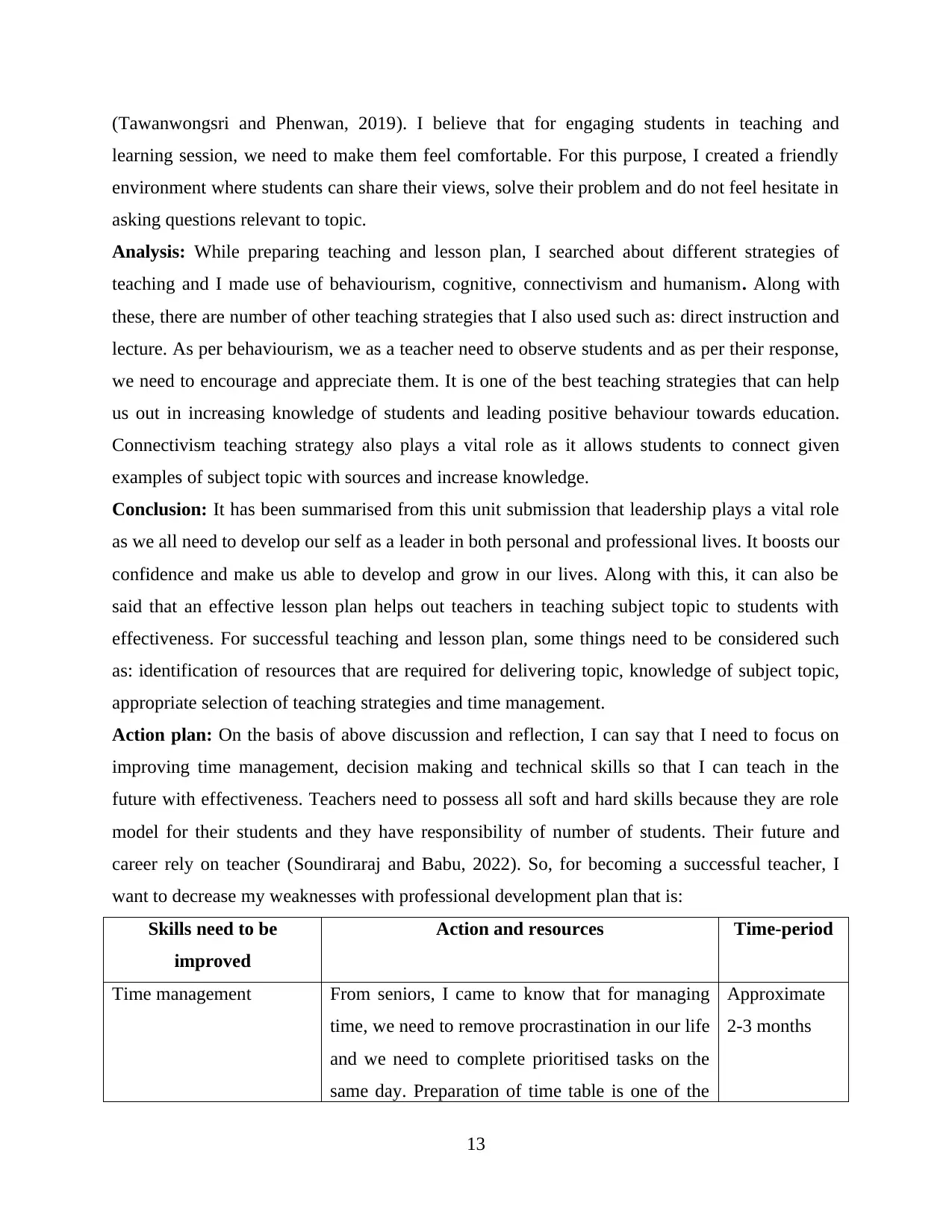
(Tawanwongsri and Phenwan, 2019). I believe that for engaging students in teaching and
learning session, we need to make them feel comfortable. For this purpose, I created a friendly
environment where students can share their views, solve their problem and do not feel hesitate in
asking questions relevant to topic.
Analysis: While preparing teaching and lesson plan, I searched about different strategies of
teaching and I made use of behaviourism, cognitive, connectivism and humanism. Along with
these, there are number of other teaching strategies that I also used such as: direct instruction and
lecture. As per behaviourism, we as a teacher need to observe students and as per their response,
we need to encourage and appreciate them. It is one of the best teaching strategies that can help
us out in increasing knowledge of students and leading positive behaviour towards education.
Connectivism teaching strategy also plays a vital role as it allows students to connect given
examples of subject topic with sources and increase knowledge.
Conclusion: It has been summarised from this unit submission that leadership plays a vital role
as we all need to develop our self as a leader in both personal and professional lives. It boosts our
confidence and make us able to develop and grow in our lives. Along with this, it can also be
said that an effective lesson plan helps out teachers in teaching subject topic to students with
effectiveness. For successful teaching and lesson plan, some things need to be considered such
as: identification of resources that are required for delivering topic, knowledge of subject topic,
appropriate selection of teaching strategies and time management.
Action plan: On the basis of above discussion and reflection, I can say that I need to focus on
improving time management, decision making and technical skills so that I can teach in the
future with effectiveness. Teachers need to possess all soft and hard skills because they are role
model for their students and they have responsibility of number of students. Their future and
career rely on teacher (Soundiraraj and Babu, 2022). So, for becoming a successful teacher, I
want to decrease my weaknesses with professional development plan that is:
Skills need to be
improved
Action and resources Time-period
Time management From seniors, I came to know that for managing
time, we need to remove procrastination in our life
and we need to complete prioritised tasks on the
same day. Preparation of time table is one of the
Approximate
2-3 months
13
learning session, we need to make them feel comfortable. For this purpose, I created a friendly
environment where students can share their views, solve their problem and do not feel hesitate in
asking questions relevant to topic.
Analysis: While preparing teaching and lesson plan, I searched about different strategies of
teaching and I made use of behaviourism, cognitive, connectivism and humanism. Along with
these, there are number of other teaching strategies that I also used such as: direct instruction and
lecture. As per behaviourism, we as a teacher need to observe students and as per their response,
we need to encourage and appreciate them. It is one of the best teaching strategies that can help
us out in increasing knowledge of students and leading positive behaviour towards education.
Connectivism teaching strategy also plays a vital role as it allows students to connect given
examples of subject topic with sources and increase knowledge.
Conclusion: It has been summarised from this unit submission that leadership plays a vital role
as we all need to develop our self as a leader in both personal and professional lives. It boosts our
confidence and make us able to develop and grow in our lives. Along with this, it can also be
said that an effective lesson plan helps out teachers in teaching subject topic to students with
effectiveness. For successful teaching and lesson plan, some things need to be considered such
as: identification of resources that are required for delivering topic, knowledge of subject topic,
appropriate selection of teaching strategies and time management.
Action plan: On the basis of above discussion and reflection, I can say that I need to focus on
improving time management, decision making and technical skills so that I can teach in the
future with effectiveness. Teachers need to possess all soft and hard skills because they are role
model for their students and they have responsibility of number of students. Their future and
career rely on teacher (Soundiraraj and Babu, 2022). So, for becoming a successful teacher, I
want to decrease my weaknesses with professional development plan that is:
Skills need to be
improved
Action and resources Time-period
Time management From seniors, I came to know that for managing
time, we need to remove procrastination in our life
and we need to complete prioritised tasks on the
same day. Preparation of time table is one of the
Approximate
2-3 months
13
Paraphrase This Document
Need a fresh take? Get an instant paraphrase of this document with our AI Paraphraser
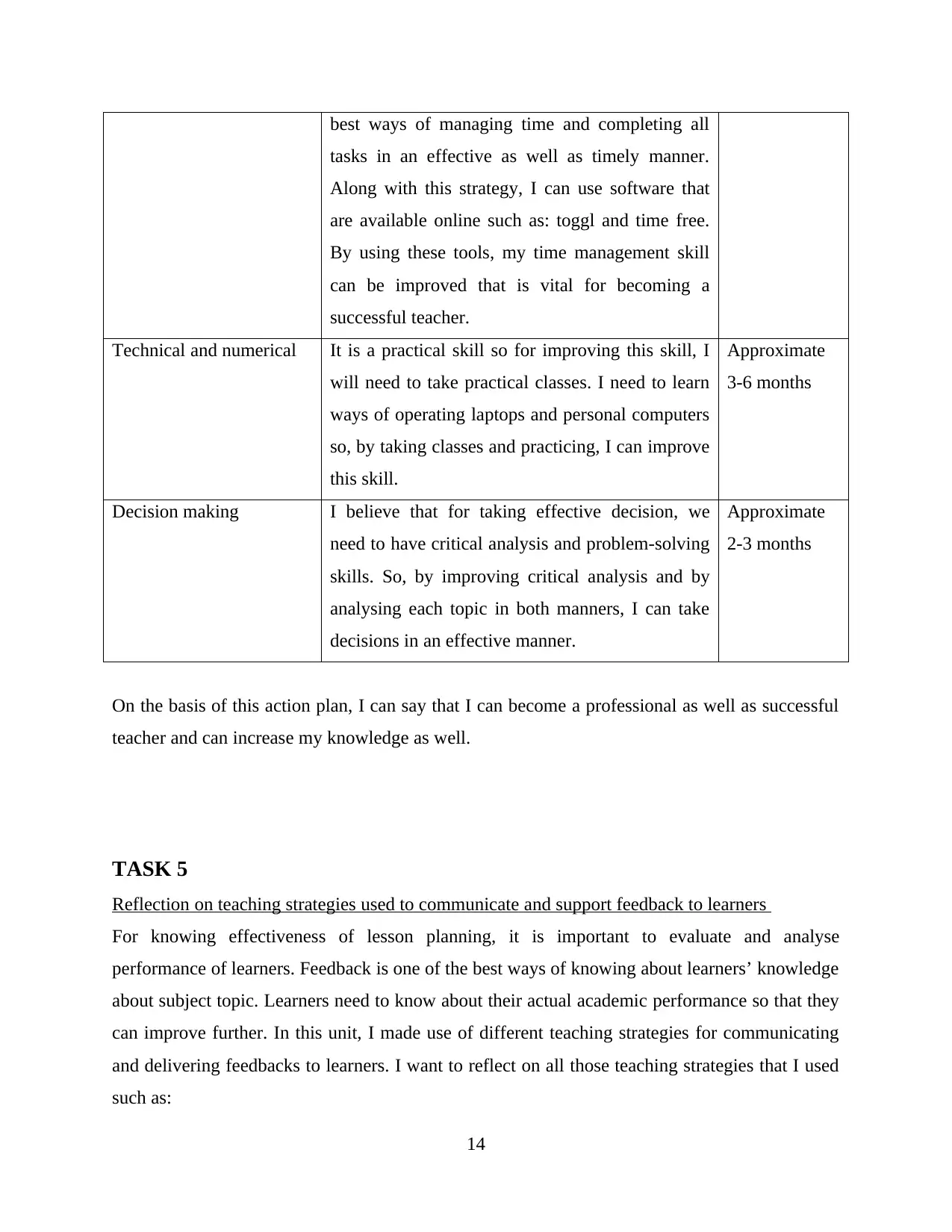
best ways of managing time and completing all
tasks in an effective as well as timely manner.
Along with this strategy, I can use software that
are available online such as: toggl and time free.
By using these tools, my time management skill
can be improved that is vital for becoming a
successful teacher.
Technical and numerical It is a practical skill so for improving this skill, I
will need to take practical classes. I need to learn
ways of operating laptops and personal computers
so, by taking classes and practicing, I can improve
this skill.
Approximate
3-6 months
Decision making I believe that for taking effective decision, we
need to have critical analysis and problem-solving
skills. So, by improving critical analysis and by
analysing each topic in both manners, I can take
decisions in an effective manner.
Approximate
2-3 months
On the basis of this action plan, I can say that I can become a professional as well as successful
teacher and can increase my knowledge as well.
TASK 5
Reflection on teaching strategies used to communicate and support feedback to learners
For knowing effectiveness of lesson planning, it is important to evaluate and analyse
performance of learners. Feedback is one of the best ways of knowing about learners’ knowledge
about subject topic. Learners need to know about their actual academic performance so that they
can improve further. In this unit, I made use of different teaching strategies for communicating
and delivering feedbacks to learners. I want to reflect on all those teaching strategies that I used
such as:
14
tasks in an effective as well as timely manner.
Along with this strategy, I can use software that
are available online such as: toggl and time free.
By using these tools, my time management skill
can be improved that is vital for becoming a
successful teacher.
Technical and numerical It is a practical skill so for improving this skill, I
will need to take practical classes. I need to learn
ways of operating laptops and personal computers
so, by taking classes and practicing, I can improve
this skill.
Approximate
3-6 months
Decision making I believe that for taking effective decision, we
need to have critical analysis and problem-solving
skills. So, by improving critical analysis and by
analysing each topic in both manners, I can take
decisions in an effective manner.
Approximate
2-3 months
On the basis of this action plan, I can say that I can become a professional as well as successful
teacher and can increase my knowledge as well.
TASK 5
Reflection on teaching strategies used to communicate and support feedback to learners
For knowing effectiveness of lesson planning, it is important to evaluate and analyse
performance of learners. Feedback is one of the best ways of knowing about learners’ knowledge
about subject topic. Learners need to know about their actual academic performance so that they
can improve further. In this unit, I made use of different teaching strategies for communicating
and delivering feedbacks to learners. I want to reflect on all those teaching strategies that I used
such as:
14
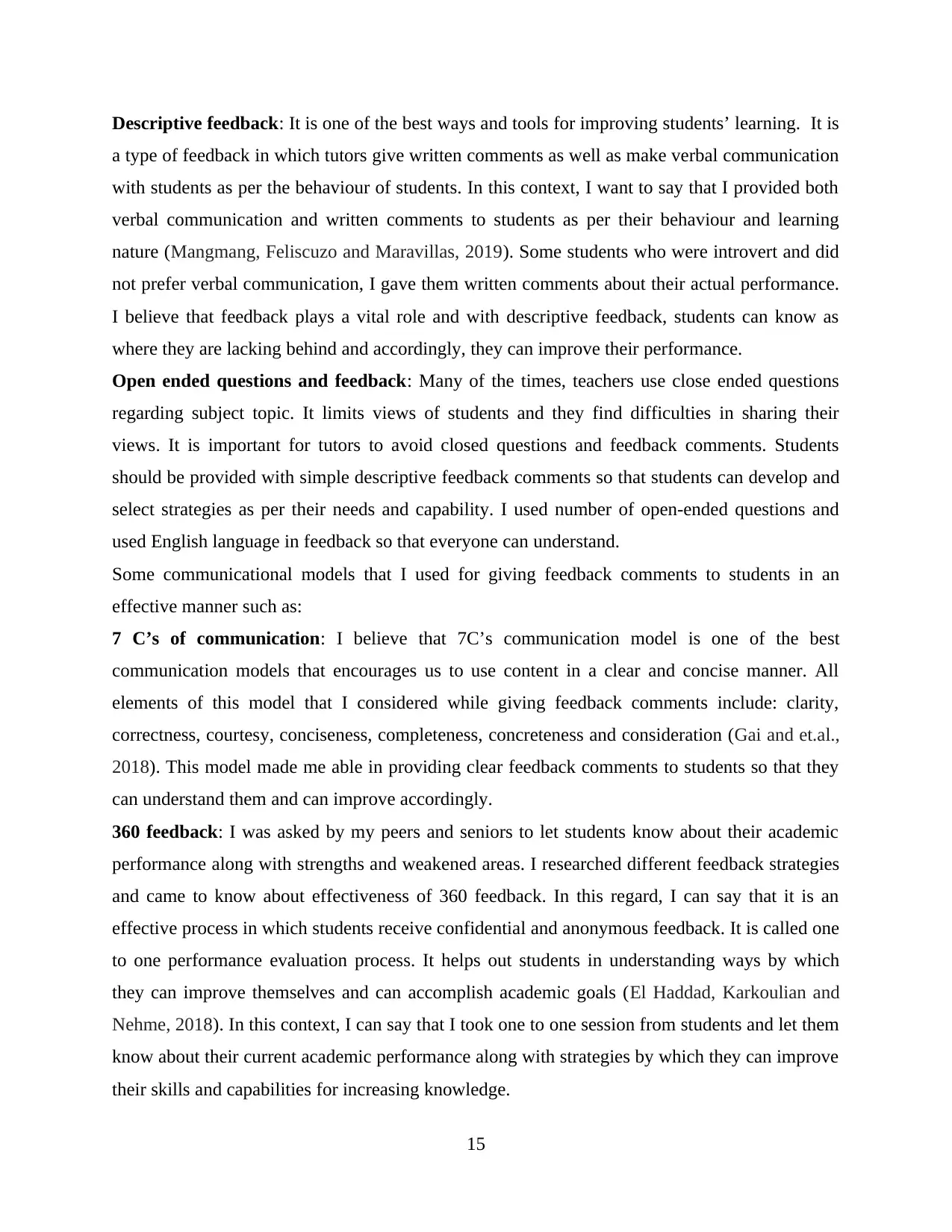
Descriptive feedback: It is one of the best ways and tools for improving students’ learning. It is
a type of feedback in which tutors give written comments as well as make verbal communication
with students as per the behaviour of students. In this context, I want to say that I provided both
verbal communication and written comments to students as per their behaviour and learning
nature (Mangmang, Feliscuzo and Maravillas, 2019). Some students who were introvert and did
not prefer verbal communication, I gave them written comments about their actual performance.
I believe that feedback plays a vital role and with descriptive feedback, students can know as
where they are lacking behind and accordingly, they can improve their performance.
Open ended questions and feedback: Many of the times, teachers use close ended questions
regarding subject topic. It limits views of students and they find difficulties in sharing their
views. It is important for tutors to avoid closed questions and feedback comments. Students
should be provided with simple descriptive feedback comments so that students can develop and
select strategies as per their needs and capability. I used number of open-ended questions and
used English language in feedback so that everyone can understand.
Some communicational models that I used for giving feedback comments to students in an
effective manner such as:
7 C’s of communication: I believe that 7C’s communication model is one of the best
communication models that encourages us to use content in a clear and concise manner. All
elements of this model that I considered while giving feedback comments include: clarity,
correctness, courtesy, conciseness, completeness, concreteness and consideration (Gai and et.al.,
2018). This model made me able in providing clear feedback comments to students so that they
can understand them and can improve accordingly.
360 feedback: I was asked by my peers and seniors to let students know about their academic
performance along with strengths and weakened areas. I researched different feedback strategies
and came to know about effectiveness of 360 feedback. In this regard, I can say that it is an
effective process in which students receive confidential and anonymous feedback. It is called one
to one performance evaluation process. It helps out students in understanding ways by which
they can improve themselves and can accomplish academic goals (El Haddad, Karkoulian and
Nehme, 2018). In this context, I can say that I took one to one session from students and let them
know about their current academic performance along with strategies by which they can improve
their skills and capabilities for increasing knowledge.
15
a type of feedback in which tutors give written comments as well as make verbal communication
with students as per the behaviour of students. In this context, I want to say that I provided both
verbal communication and written comments to students as per their behaviour and learning
nature (Mangmang, Feliscuzo and Maravillas, 2019). Some students who were introvert and did
not prefer verbal communication, I gave them written comments about their actual performance.
I believe that feedback plays a vital role and with descriptive feedback, students can know as
where they are lacking behind and accordingly, they can improve their performance.
Open ended questions and feedback: Many of the times, teachers use close ended questions
regarding subject topic. It limits views of students and they find difficulties in sharing their
views. It is important for tutors to avoid closed questions and feedback comments. Students
should be provided with simple descriptive feedback comments so that students can develop and
select strategies as per their needs and capability. I used number of open-ended questions and
used English language in feedback so that everyone can understand.
Some communicational models that I used for giving feedback comments to students in an
effective manner such as:
7 C’s of communication: I believe that 7C’s communication model is one of the best
communication models that encourages us to use content in a clear and concise manner. All
elements of this model that I considered while giving feedback comments include: clarity,
correctness, courtesy, conciseness, completeness, concreteness and consideration (Gai and et.al.,
2018). This model made me able in providing clear feedback comments to students so that they
can understand them and can improve accordingly.
360 feedback: I was asked by my peers and seniors to let students know about their academic
performance along with strengths and weakened areas. I researched different feedback strategies
and came to know about effectiveness of 360 feedback. In this regard, I can say that it is an
effective process in which students receive confidential and anonymous feedback. It is called one
to one performance evaluation process. It helps out students in understanding ways by which
they can improve themselves and can accomplish academic goals (El Haddad, Karkoulian and
Nehme, 2018). In this context, I can say that I took one to one session from students and let them
know about their current academic performance along with strategies by which they can improve
their skills and capabilities for increasing knowledge.
15
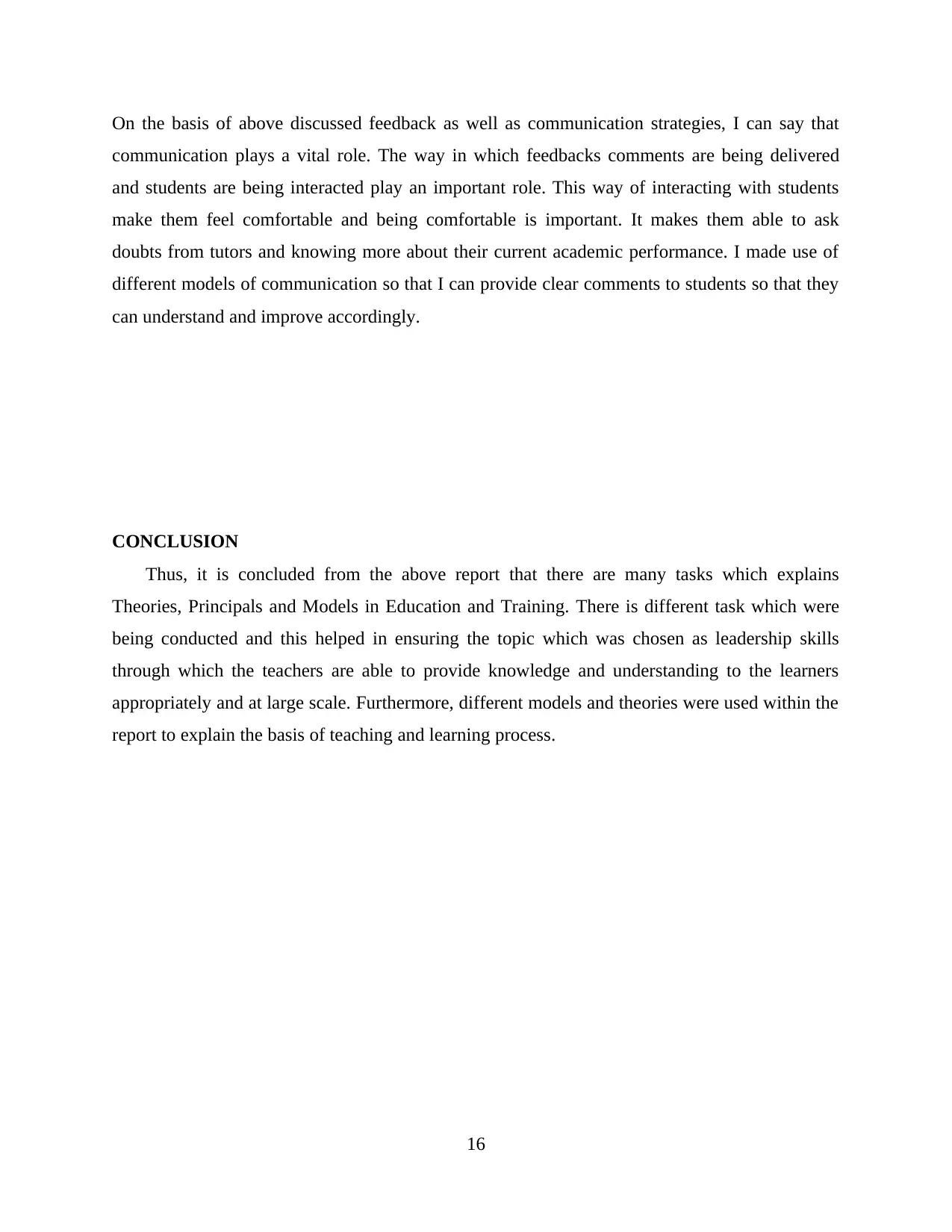
On the basis of above discussed feedback as well as communication strategies, I can say that
communication plays a vital role. The way in which feedbacks comments are being delivered
and students are being interacted play an important role. This way of interacting with students
make them feel comfortable and being comfortable is important. It makes them able to ask
doubts from tutors and knowing more about their current academic performance. I made use of
different models of communication so that I can provide clear comments to students so that they
can understand and improve accordingly.
CONCLUSION
Thus, it is concluded from the above report that there are many tasks which explains
Theories, Principals and Models in Education and Training. There is different task which were
being conducted and this helped in ensuring the topic which was chosen as leadership skills
through which the teachers are able to provide knowledge and understanding to the learners
appropriately and at large scale. Furthermore, different models and theories were used within the
report to explain the basis of teaching and learning process.
16
communication plays a vital role. The way in which feedbacks comments are being delivered
and students are being interacted play an important role. This way of interacting with students
make them feel comfortable and being comfortable is important. It makes them able to ask
doubts from tutors and knowing more about their current academic performance. I made use of
different models of communication so that I can provide clear comments to students so that they
can understand and improve accordingly.
CONCLUSION
Thus, it is concluded from the above report that there are many tasks which explains
Theories, Principals and Models in Education and Training. There is different task which were
being conducted and this helped in ensuring the topic which was chosen as leadership skills
through which the teachers are able to provide knowledge and understanding to the learners
appropriately and at large scale. Furthermore, different models and theories were used within the
report to explain the basis of teaching and learning process.
16
Secure Best Marks with AI Grader
Need help grading? Try our AI Grader for instant feedback on your assignments.
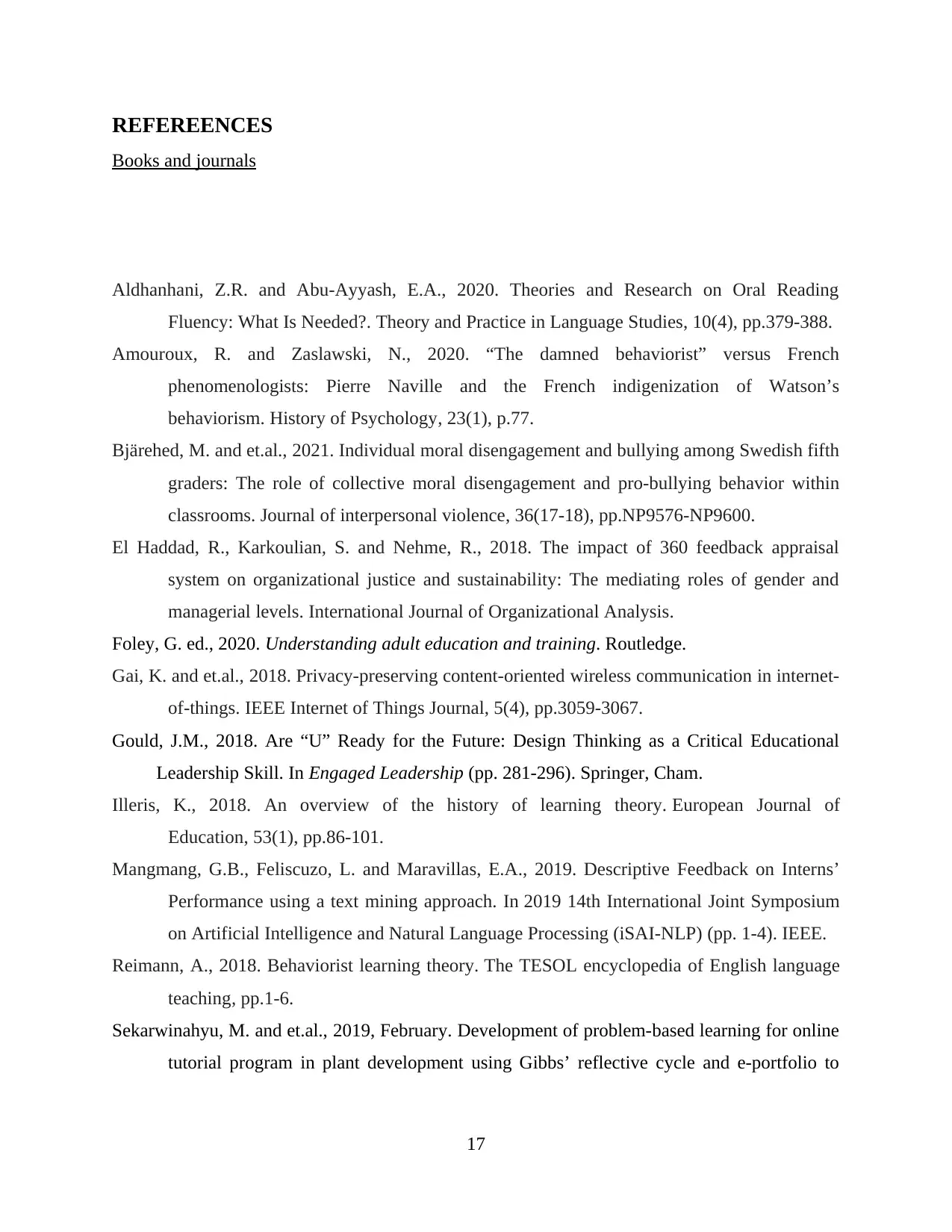
REFEREENCES
Books and journals
Aldhanhani, Z.R. and Abu-Ayyash, E.A., 2020. Theories and Research on Oral Reading
Fluency: What Is Needed?. Theory and Practice in Language Studies, 10(4), pp.379-388.
Amouroux, R. and Zaslawski, N., 2020. “The damned behaviorist” versus French
phenomenologists: Pierre Naville and the French indigenization of Watson’s
behaviorism. History of Psychology, 23(1), p.77.
Bjärehed, M. and et.al., 2021. Individual moral disengagement and bullying among Swedish fifth
graders: The role of collective moral disengagement and pro-bullying behavior within
classrooms. Journal of interpersonal violence, 36(17-18), pp.NP9576-NP9600.
El Haddad, R., Karkoulian, S. and Nehme, R., 2018. The impact of 360 feedback appraisal
system on organizational justice and sustainability: The mediating roles of gender and
managerial levels. International Journal of Organizational Analysis.
Foley, G. ed., 2020. Understanding adult education and training. Routledge.
Gai, K. and et.al., 2018. Privacy-preserving content-oriented wireless communication in internet-
of-things. IEEE Internet of Things Journal, 5(4), pp.3059-3067.
Gould, J.M., 2018. Are “U” Ready for the Future: Design Thinking as a Critical Educational
Leadership Skill. In Engaged Leadership (pp. 281-296). Springer, Cham.
Illeris, K., 2018. An overview of the history of learning theory. European Journal of
Education, 53(1), pp.86-101.
Mangmang, G.B., Feliscuzo, L. and Maravillas, E.A., 2019. Descriptive Feedback on Interns’
Performance using a text mining approach. In 2019 14th International Joint Symposium
on Artificial Intelligence and Natural Language Processing (iSAI-NLP) (pp. 1-4). IEEE.
Reimann, A., 2018. Behaviorist learning theory. The TESOL encyclopedia of English language
teaching, pp.1-6.
Sekarwinahyu, M. and et.al., 2019, February. Development of problem-based learning for online
tutorial program in plant development using Gibbs’ reflective cycle and e-portfolio to
17
Books and journals
Aldhanhani, Z.R. and Abu-Ayyash, E.A., 2020. Theories and Research on Oral Reading
Fluency: What Is Needed?. Theory and Practice in Language Studies, 10(4), pp.379-388.
Amouroux, R. and Zaslawski, N., 2020. “The damned behaviorist” versus French
phenomenologists: Pierre Naville and the French indigenization of Watson’s
behaviorism. History of Psychology, 23(1), p.77.
Bjärehed, M. and et.al., 2021. Individual moral disengagement and bullying among Swedish fifth
graders: The role of collective moral disengagement and pro-bullying behavior within
classrooms. Journal of interpersonal violence, 36(17-18), pp.NP9576-NP9600.
El Haddad, R., Karkoulian, S. and Nehme, R., 2018. The impact of 360 feedback appraisal
system on organizational justice and sustainability: The mediating roles of gender and
managerial levels. International Journal of Organizational Analysis.
Foley, G. ed., 2020. Understanding adult education and training. Routledge.
Gai, K. and et.al., 2018. Privacy-preserving content-oriented wireless communication in internet-
of-things. IEEE Internet of Things Journal, 5(4), pp.3059-3067.
Gould, J.M., 2018. Are “U” Ready for the Future: Design Thinking as a Critical Educational
Leadership Skill. In Engaged Leadership (pp. 281-296). Springer, Cham.
Illeris, K., 2018. An overview of the history of learning theory. European Journal of
Education, 53(1), pp.86-101.
Mangmang, G.B., Feliscuzo, L. and Maravillas, E.A., 2019. Descriptive Feedback on Interns’
Performance using a text mining approach. In 2019 14th International Joint Symposium
on Artificial Intelligence and Natural Language Processing (iSAI-NLP) (pp. 1-4). IEEE.
Reimann, A., 2018. Behaviorist learning theory. The TESOL encyclopedia of English language
teaching, pp.1-6.
Sekarwinahyu, M. and et.al., 2019, February. Development of problem-based learning for online
tutorial program in plant development using Gibbs’ reflective cycle and e-portfolio to
17
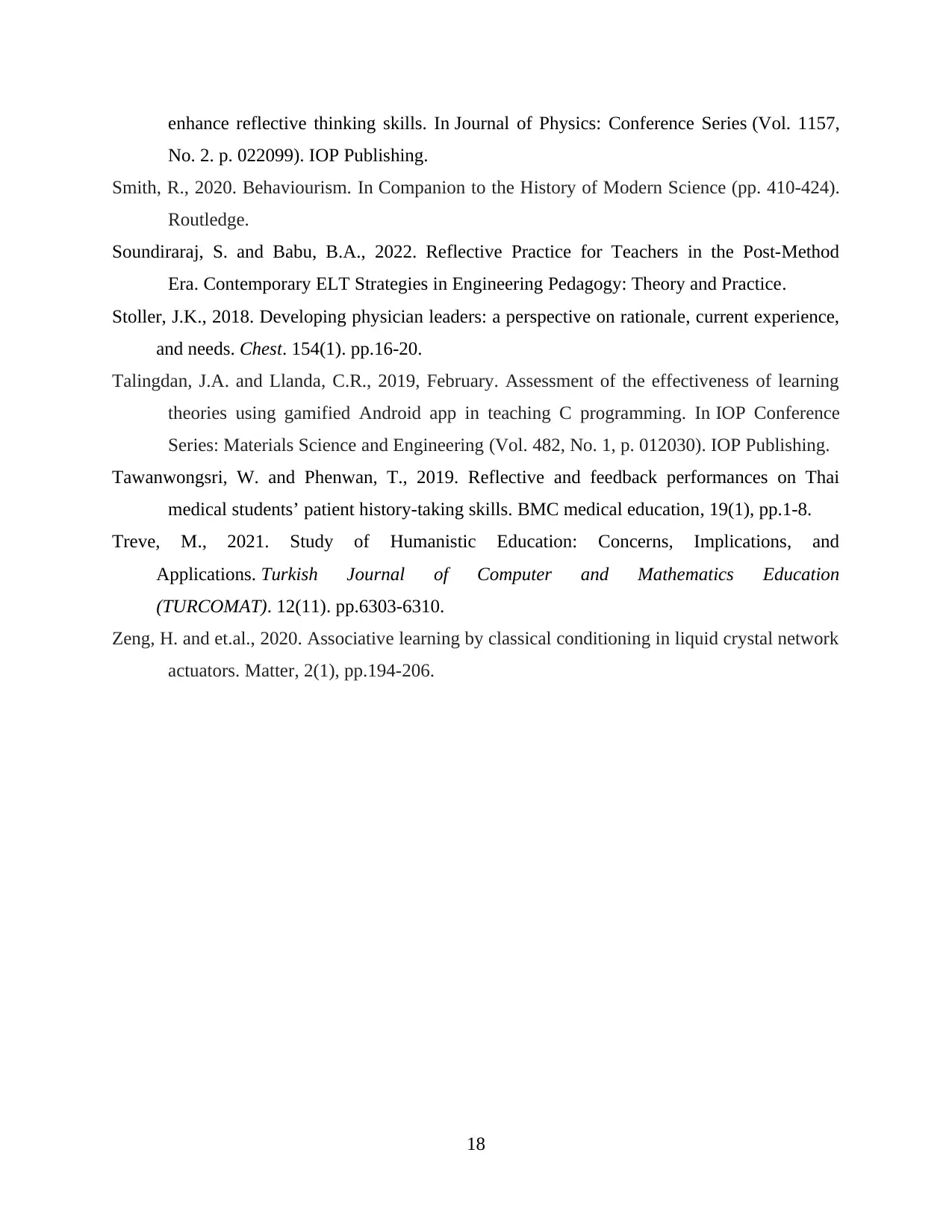
enhance reflective thinking skills. In Journal of Physics: Conference Series (Vol. 1157,
No. 2. p. 022099). IOP Publishing.
Smith, R., 2020. Behaviourism. In Companion to the History of Modern Science (pp. 410-424).
Routledge.
Soundiraraj, S. and Babu, B.A., 2022. Reflective Practice for Teachers in the Post-Method
Era. Contemporary ELT Strategies in Engineering Pedagogy: Theory and Practice.
Stoller, J.K., 2018. Developing physician leaders: a perspective on rationale, current experience,
and needs. Chest. 154(1). pp.16-20.
Talingdan, J.A. and Llanda, C.R., 2019, February. Assessment of the effectiveness of learning
theories using gamified Android app in teaching C programming. In IOP Conference
Series: Materials Science and Engineering (Vol. 482, No. 1, p. 012030). IOP Publishing.
Tawanwongsri, W. and Phenwan, T., 2019. Reflective and feedback performances on Thai
medical students’ patient history-taking skills. BMC medical education, 19(1), pp.1-8.
Treve, M., 2021. Study of Humanistic Education: Concerns, Implications, and
Applications. Turkish Journal of Computer and Mathematics Education
(TURCOMAT). 12(11). pp.6303-6310.
Zeng, H. and et.al., 2020. Associative learning by classical conditioning in liquid crystal network
actuators. Matter, 2(1), pp.194-206.
18
No. 2. p. 022099). IOP Publishing.
Smith, R., 2020. Behaviourism. In Companion to the History of Modern Science (pp. 410-424).
Routledge.
Soundiraraj, S. and Babu, B.A., 2022. Reflective Practice for Teachers in the Post-Method
Era. Contemporary ELT Strategies in Engineering Pedagogy: Theory and Practice.
Stoller, J.K., 2018. Developing physician leaders: a perspective on rationale, current experience,
and needs. Chest. 154(1). pp.16-20.
Talingdan, J.A. and Llanda, C.R., 2019, February. Assessment of the effectiveness of learning
theories using gamified Android app in teaching C programming. In IOP Conference
Series: Materials Science and Engineering (Vol. 482, No. 1, p. 012030). IOP Publishing.
Tawanwongsri, W. and Phenwan, T., 2019. Reflective and feedback performances on Thai
medical students’ patient history-taking skills. BMC medical education, 19(1), pp.1-8.
Treve, M., 2021. Study of Humanistic Education: Concerns, Implications, and
Applications. Turkish Journal of Computer and Mathematics Education
(TURCOMAT). 12(11). pp.6303-6310.
Zeng, H. and et.al., 2020. Associative learning by classical conditioning in liquid crystal network
actuators. Matter, 2(1), pp.194-206.
18
1 out of 18
Related Documents
Your All-in-One AI-Powered Toolkit for Academic Success.
+13062052269
info@desklib.com
Available 24*7 on WhatsApp / Email
![[object Object]](/_next/static/media/star-bottom.7253800d.svg)
Unlock your academic potential
© 2024 | Zucol Services PVT LTD | All rights reserved.





